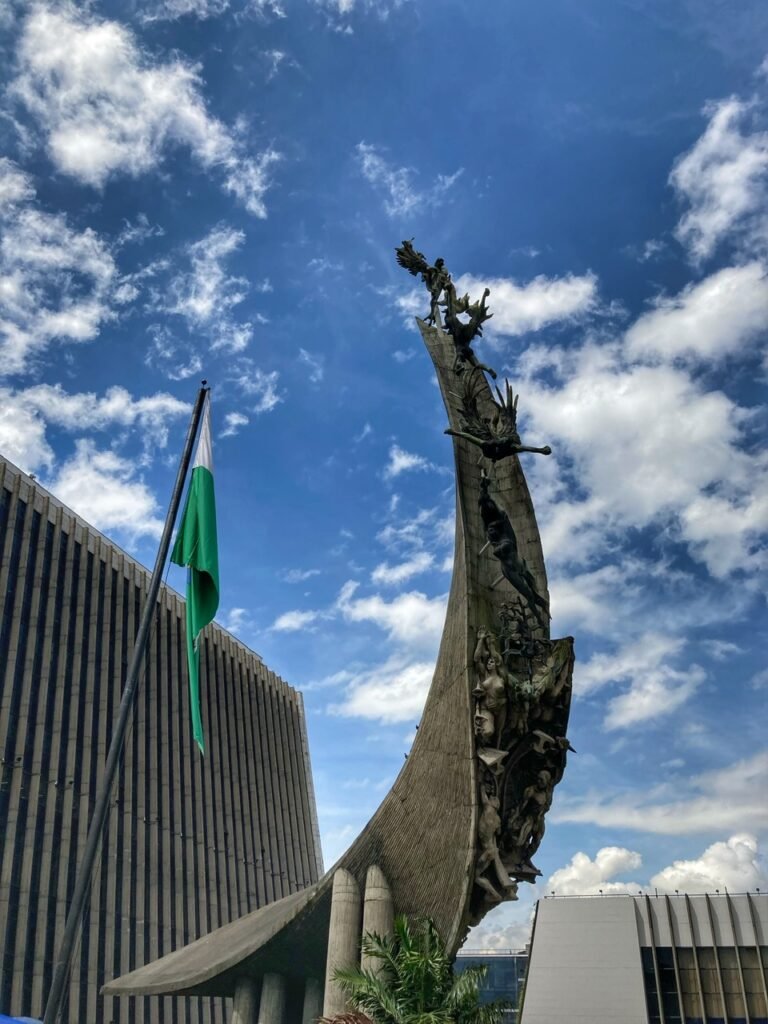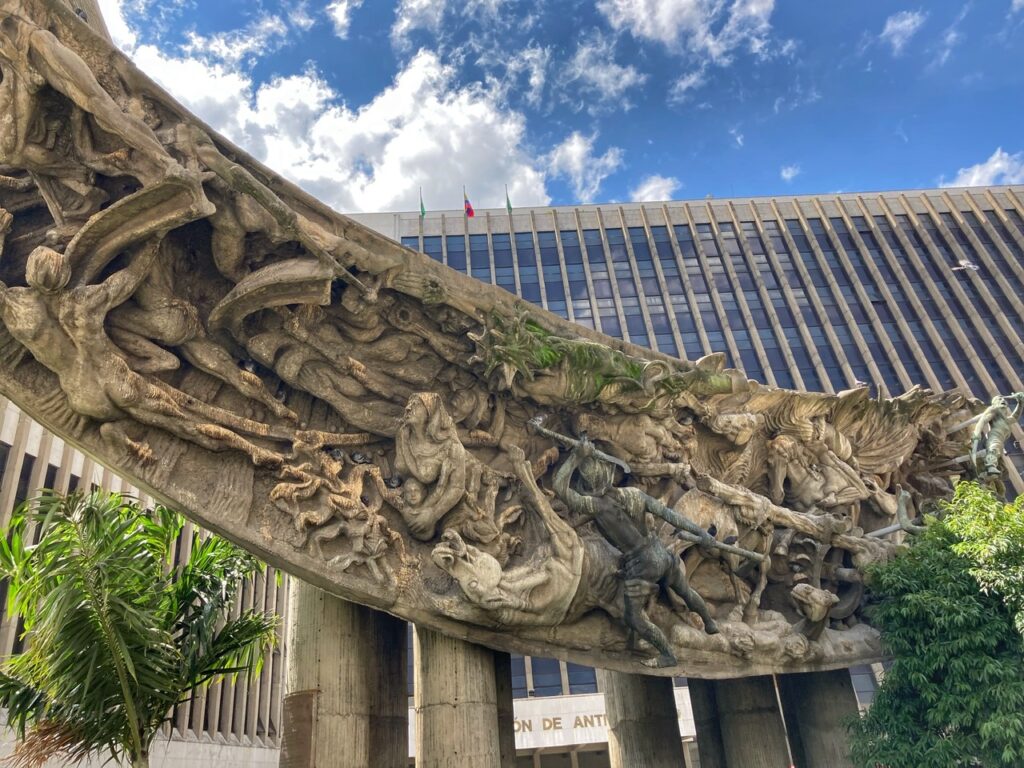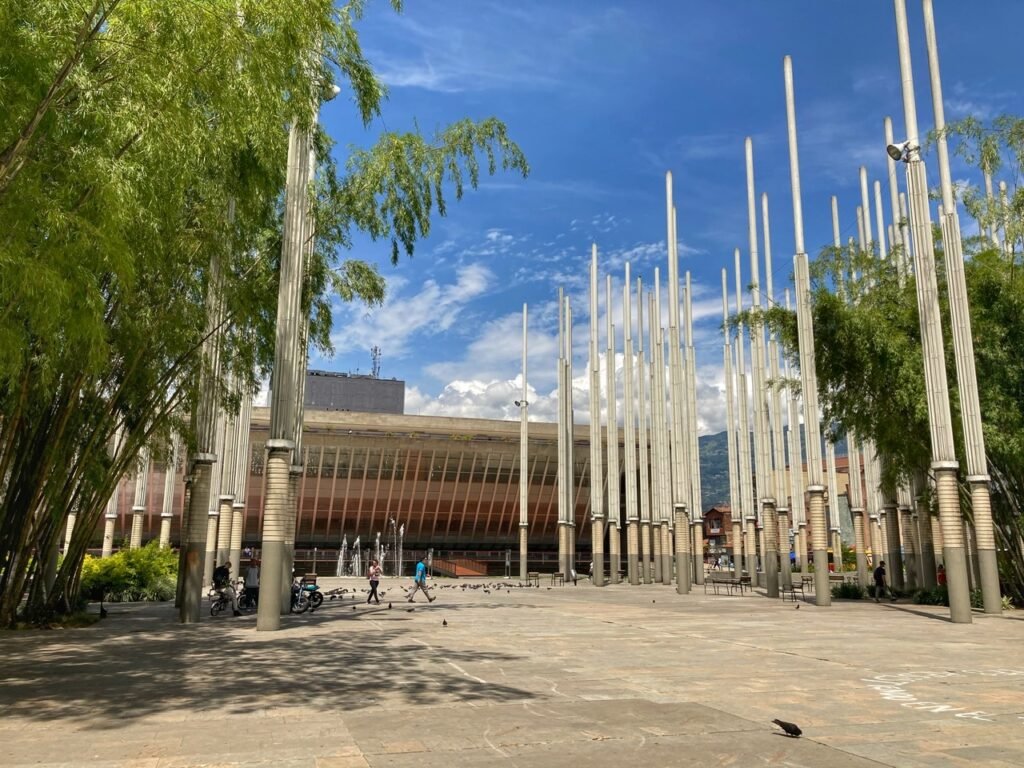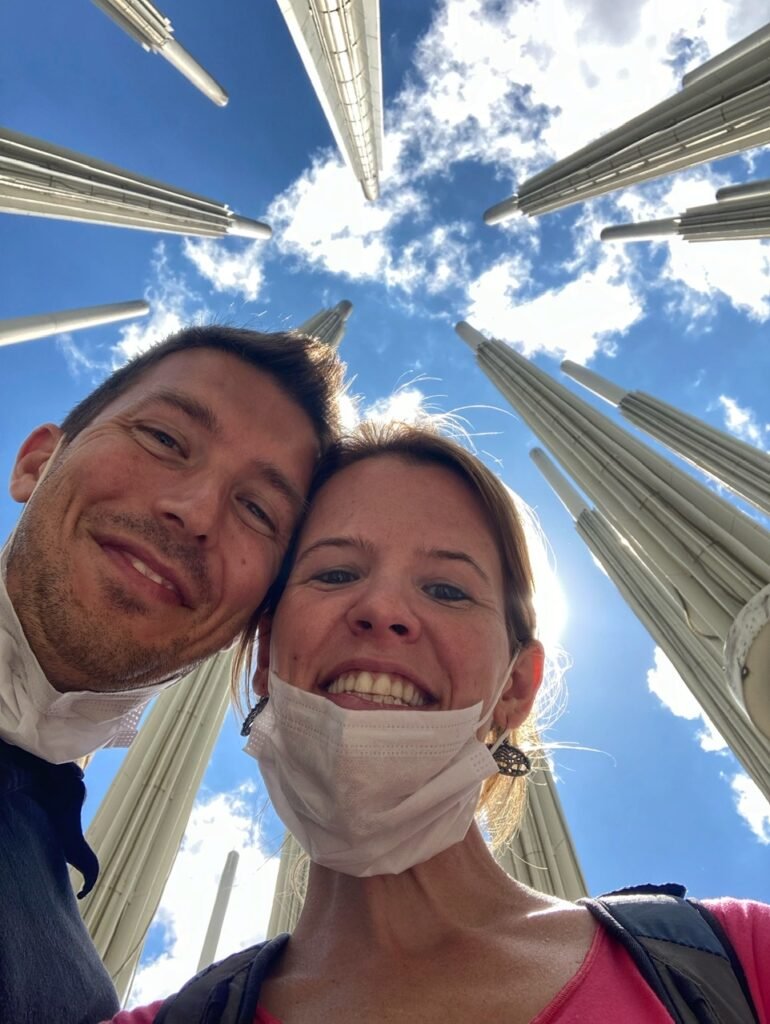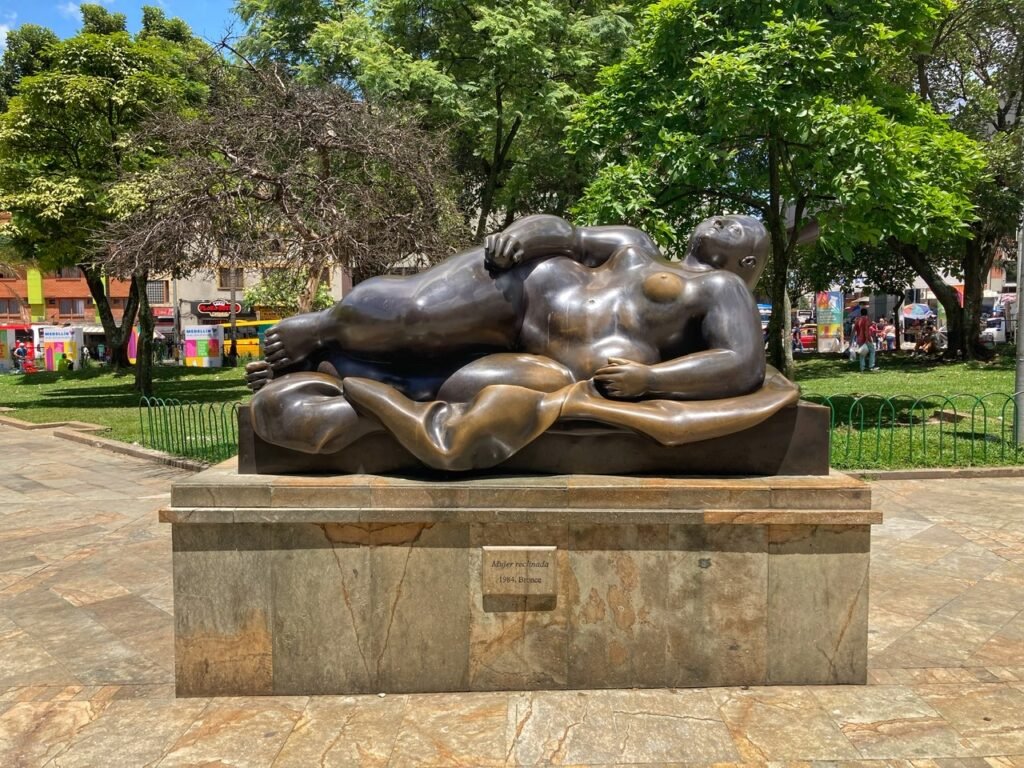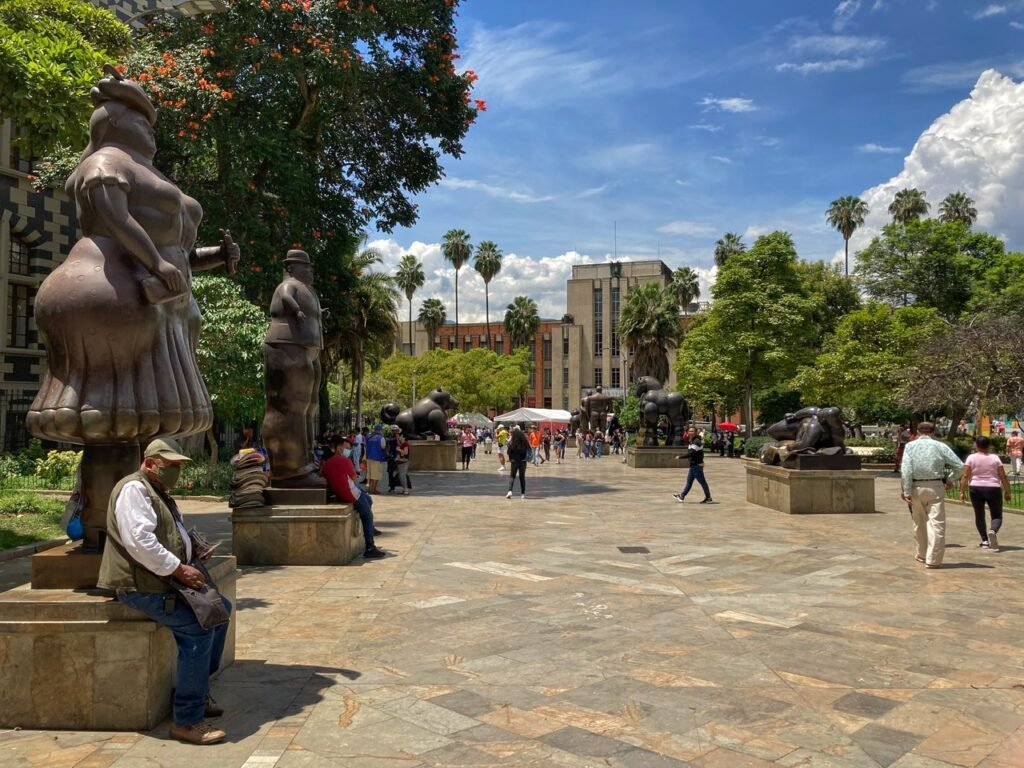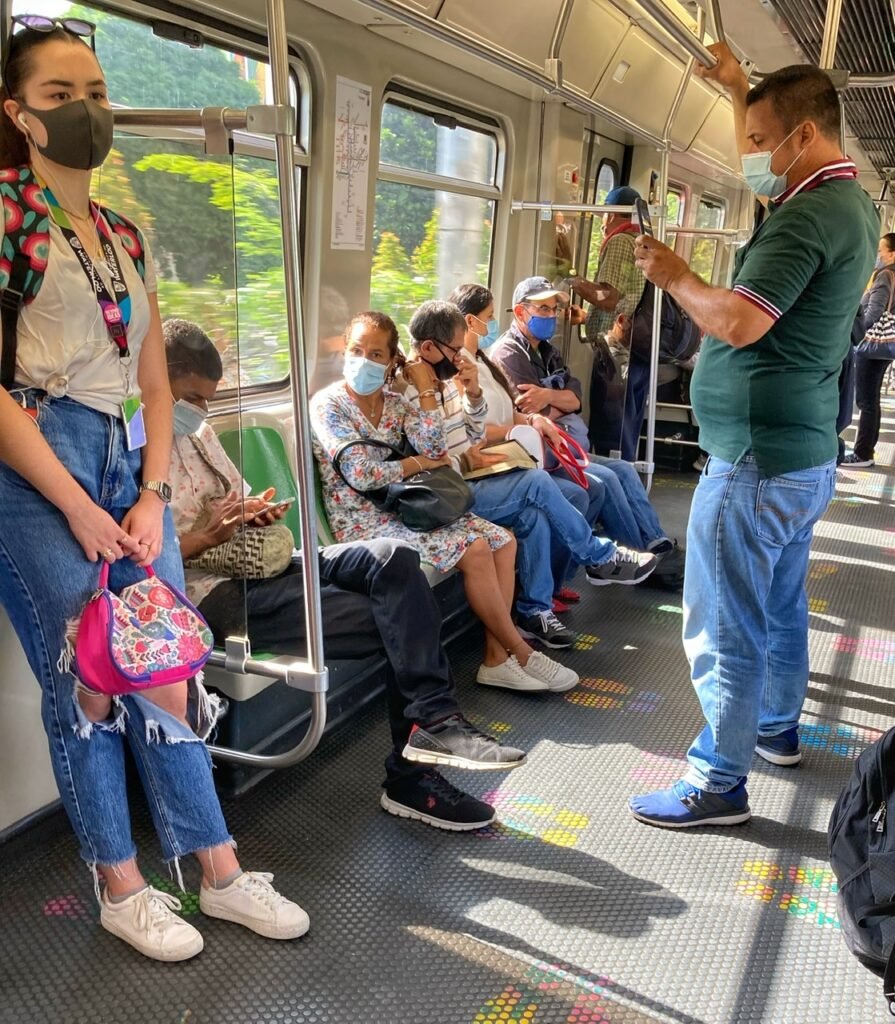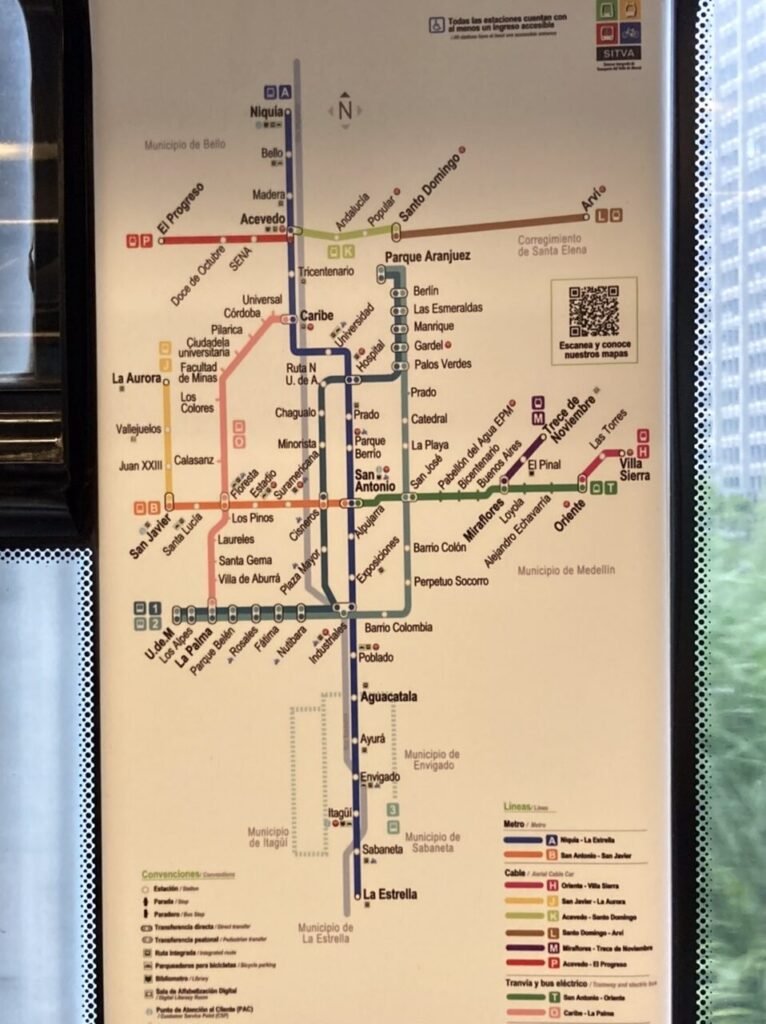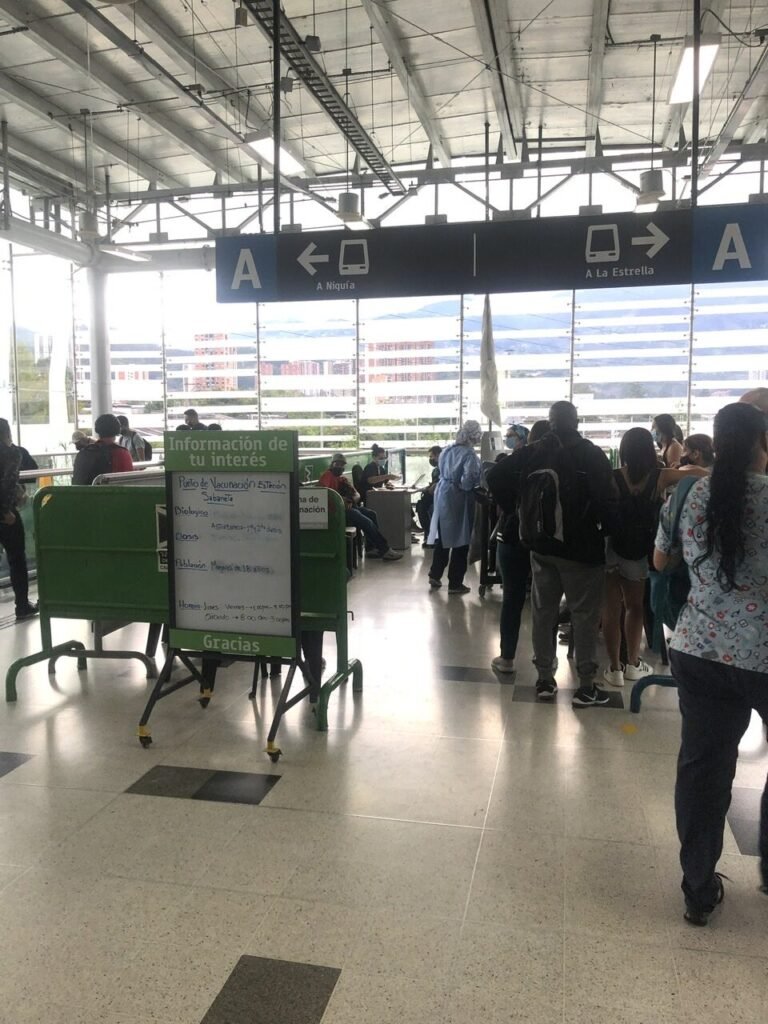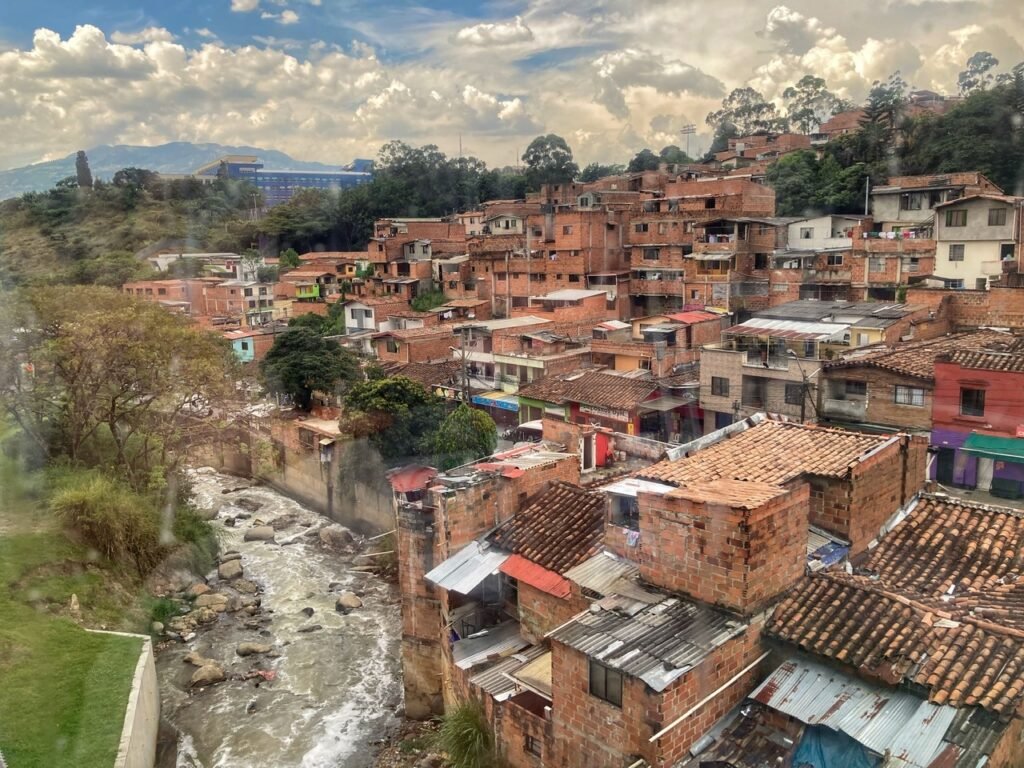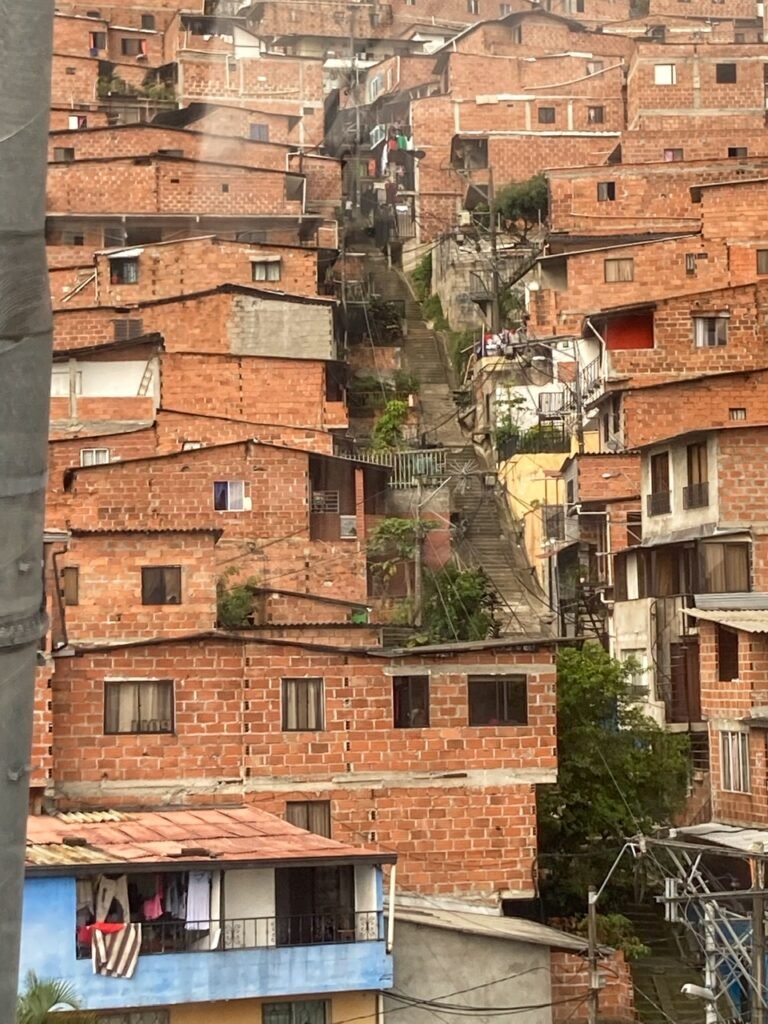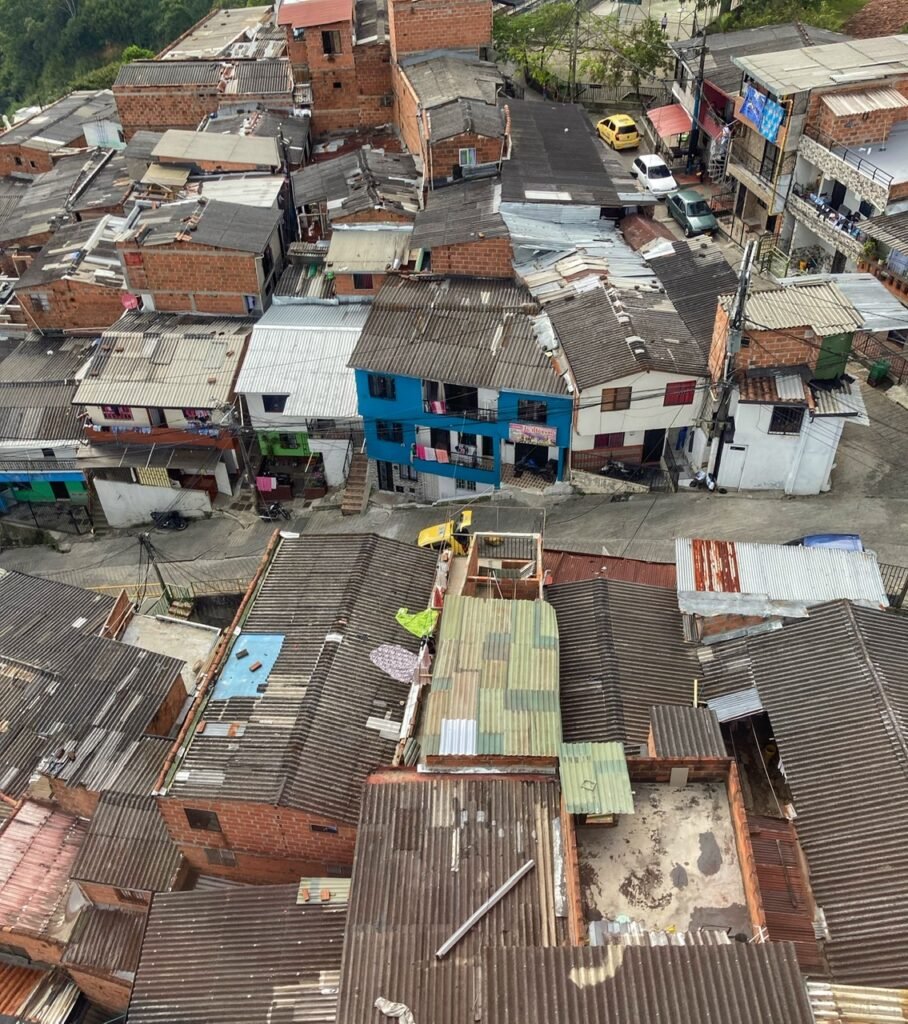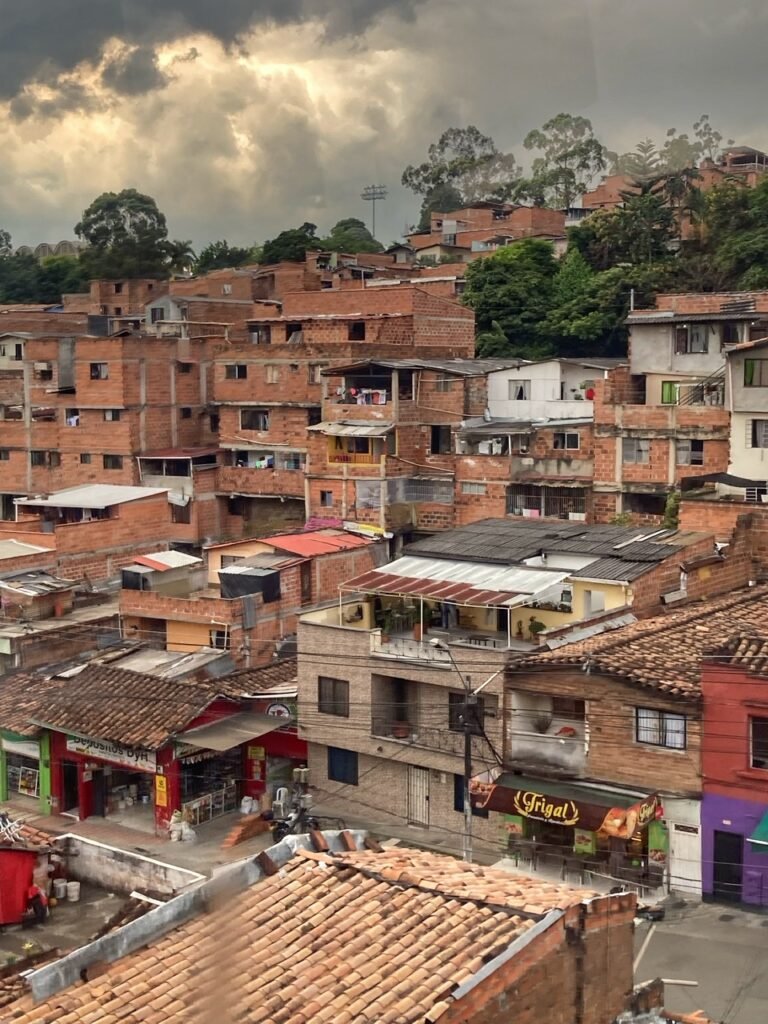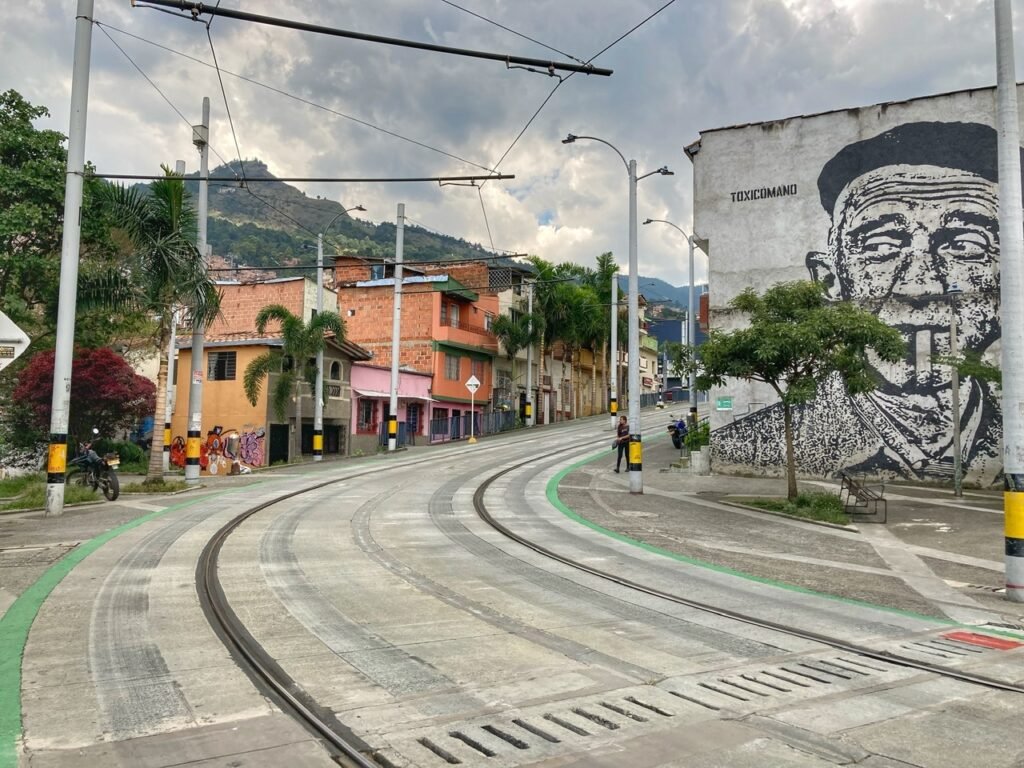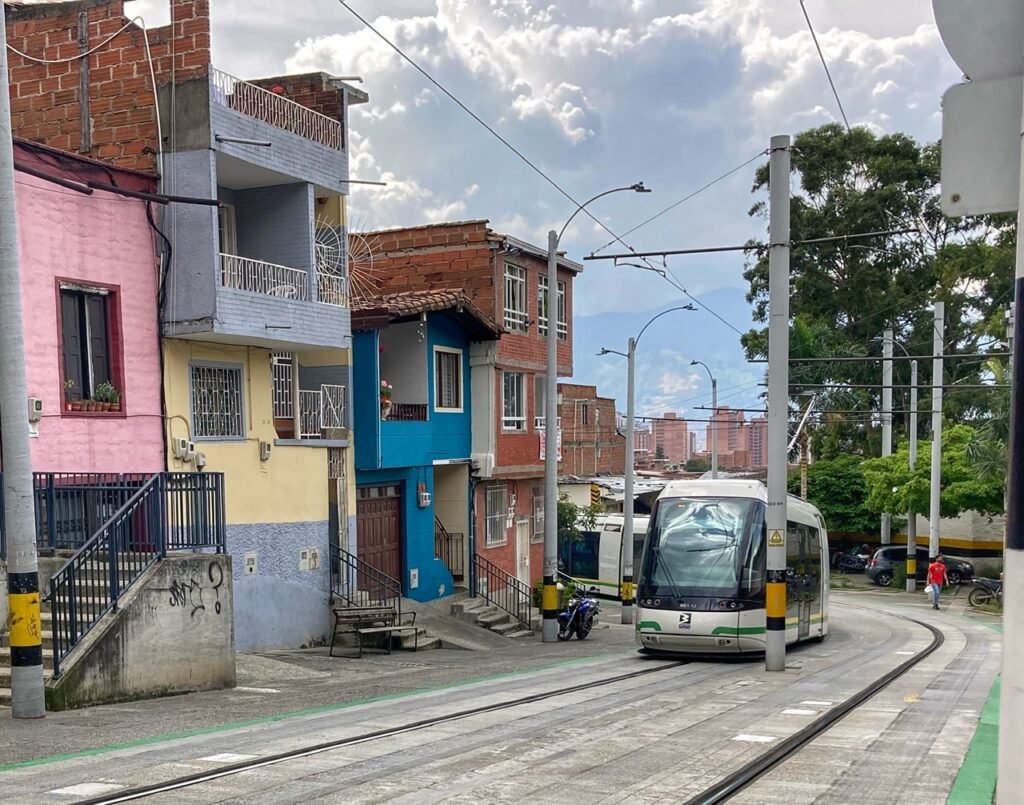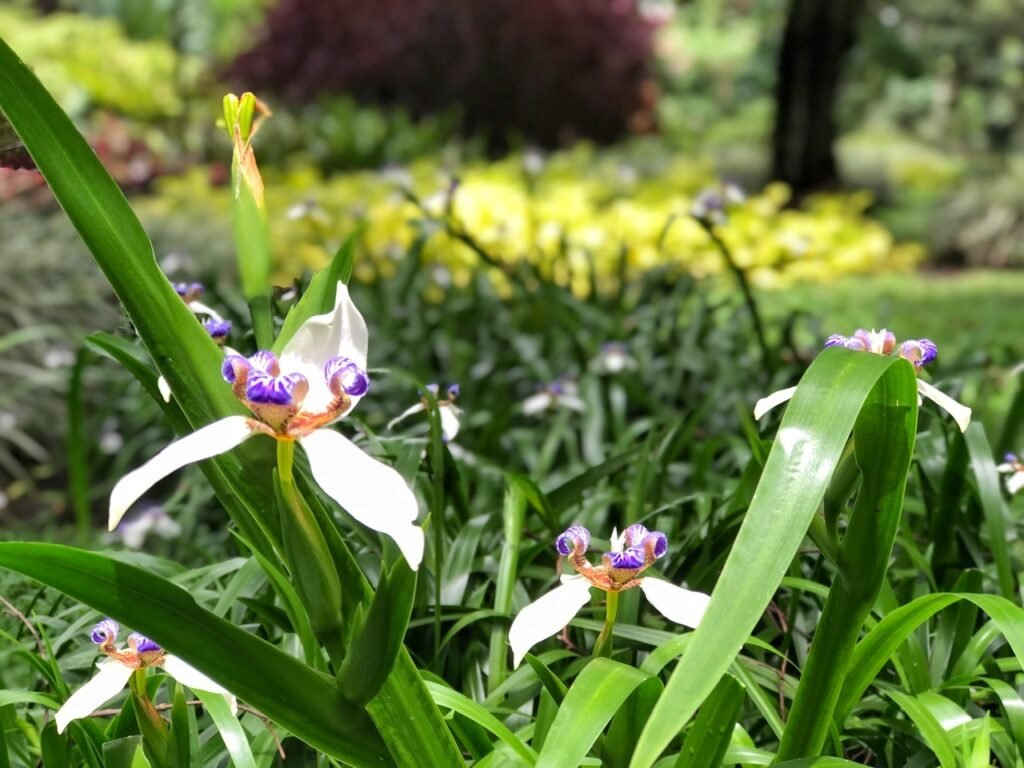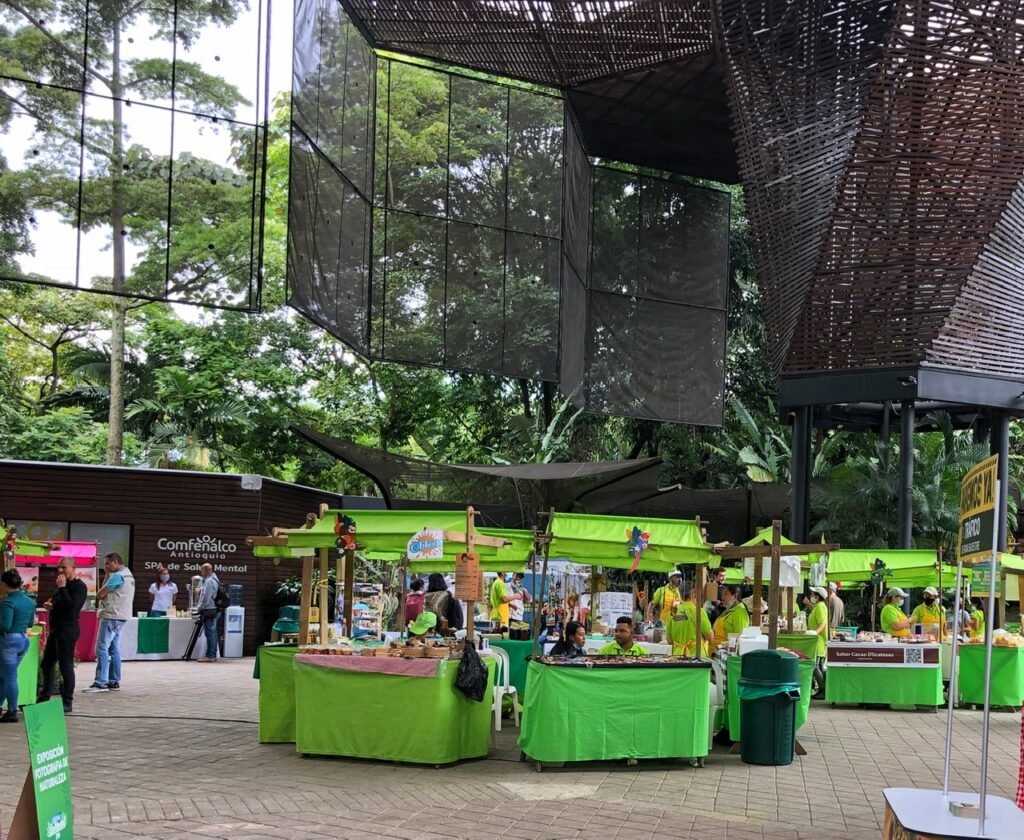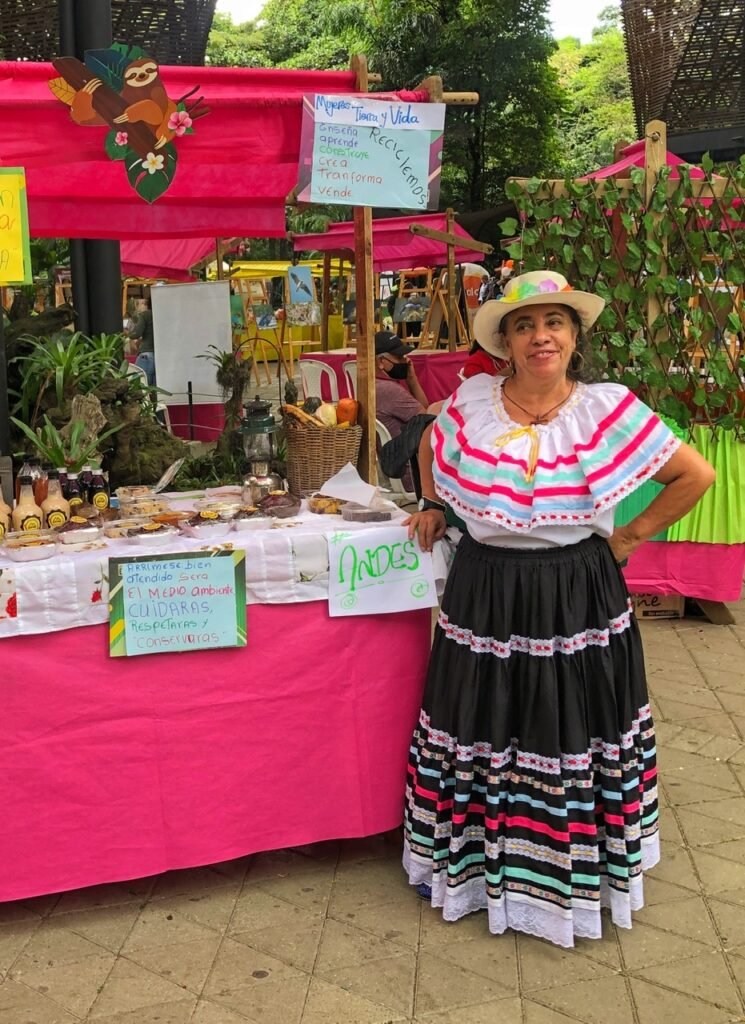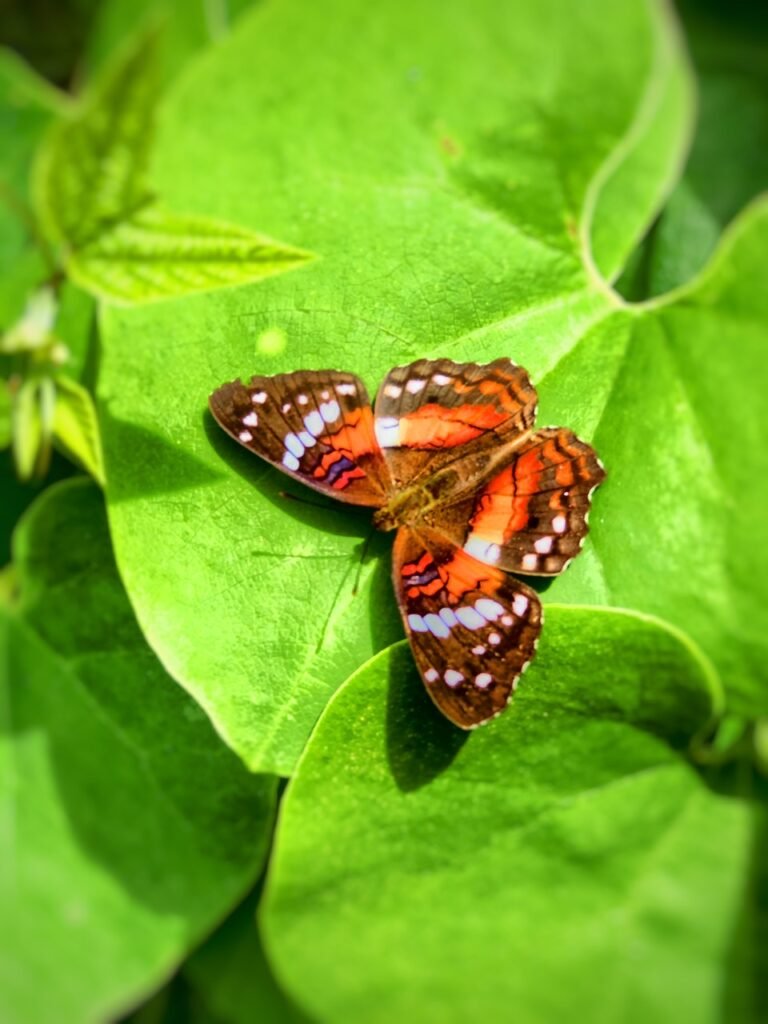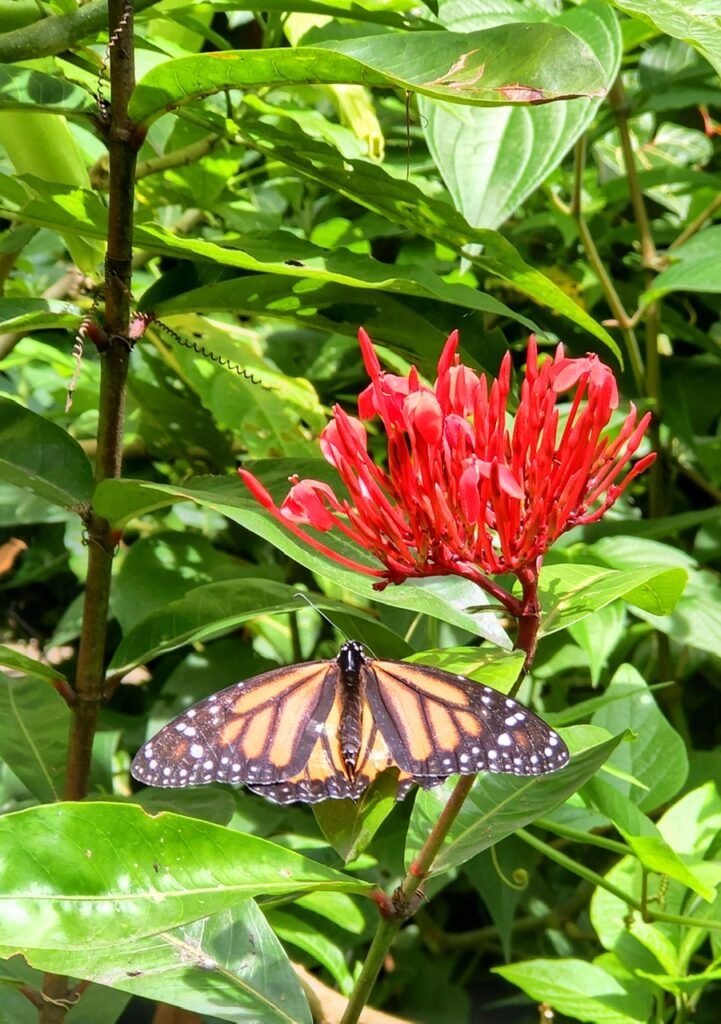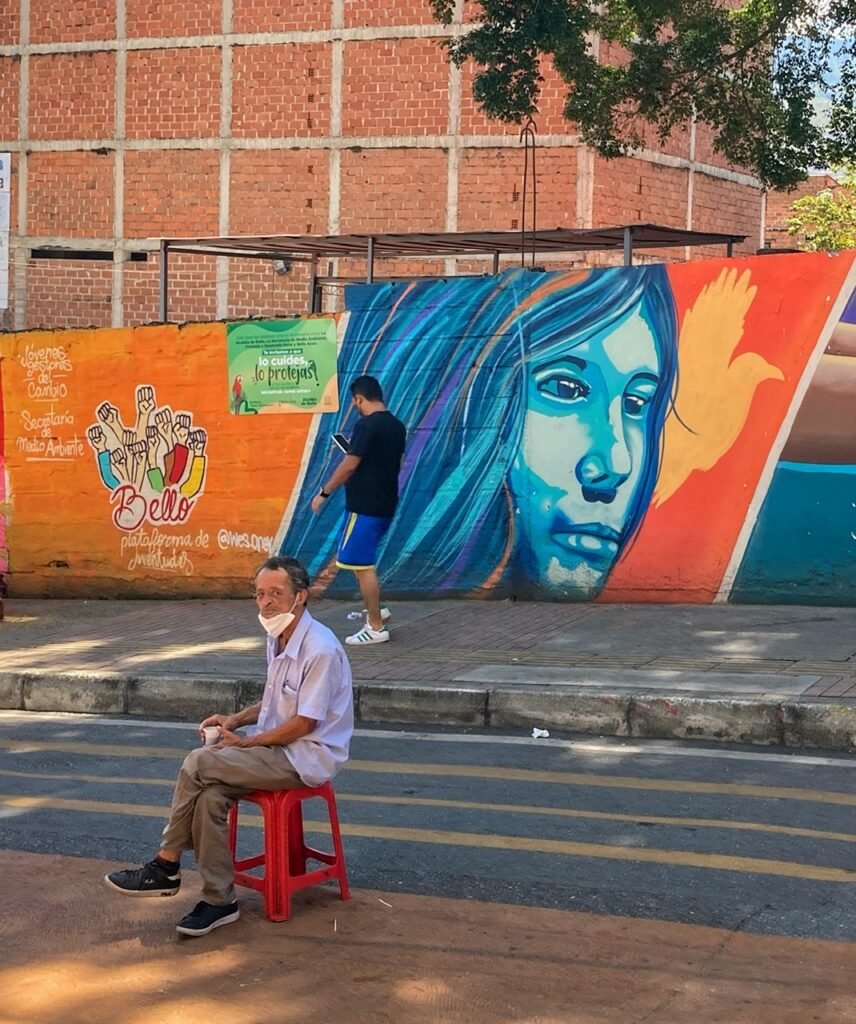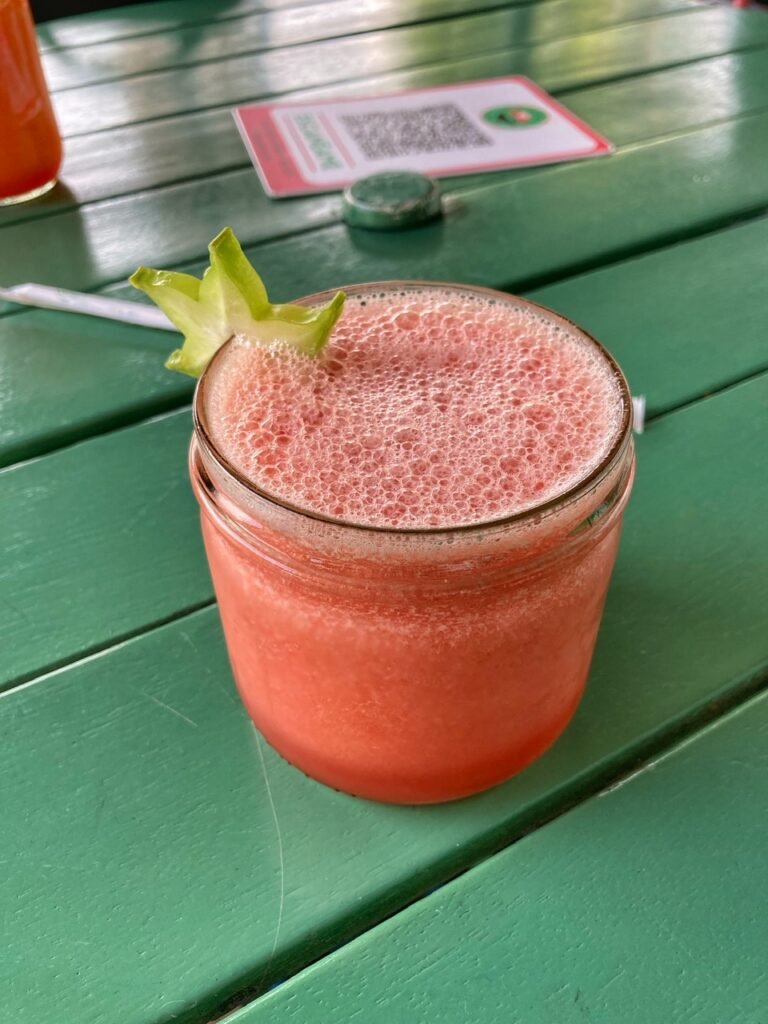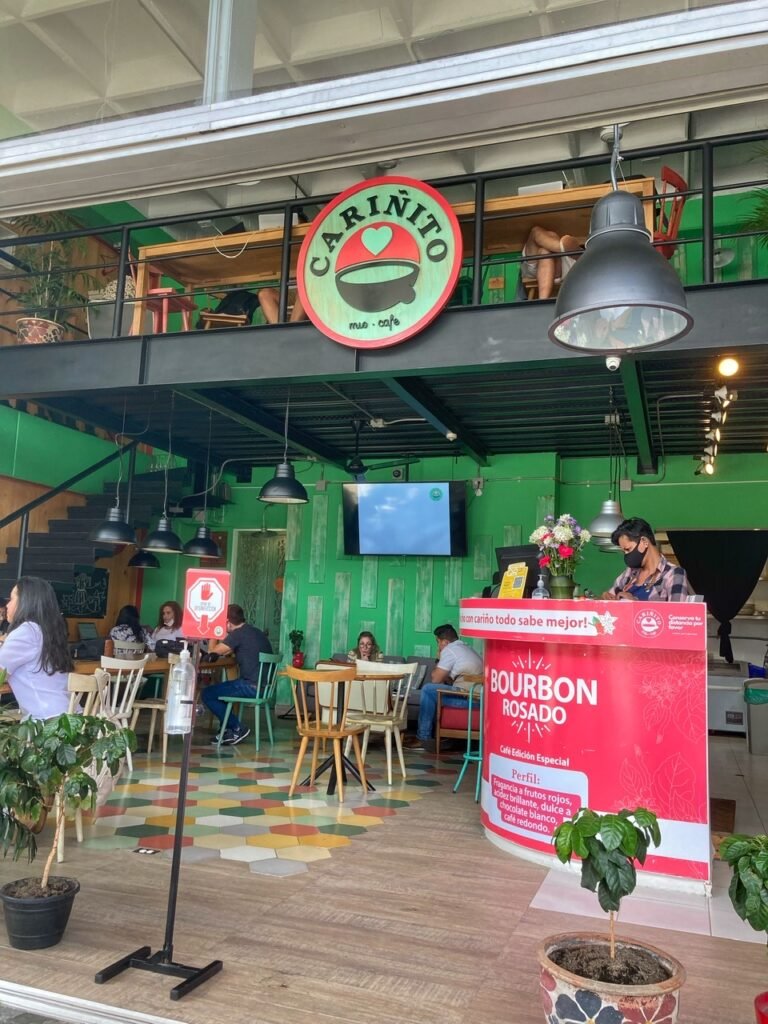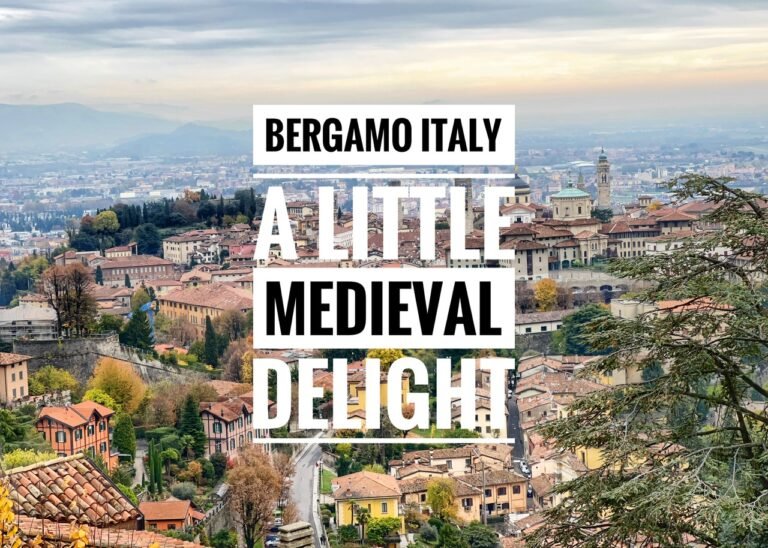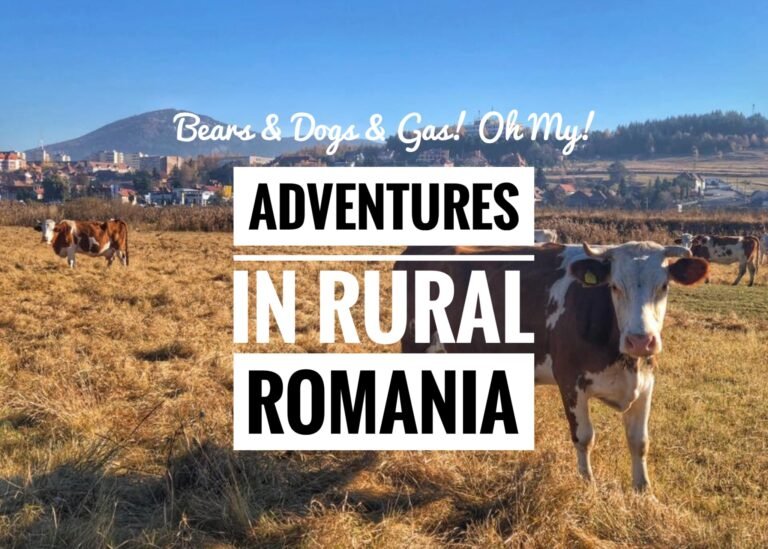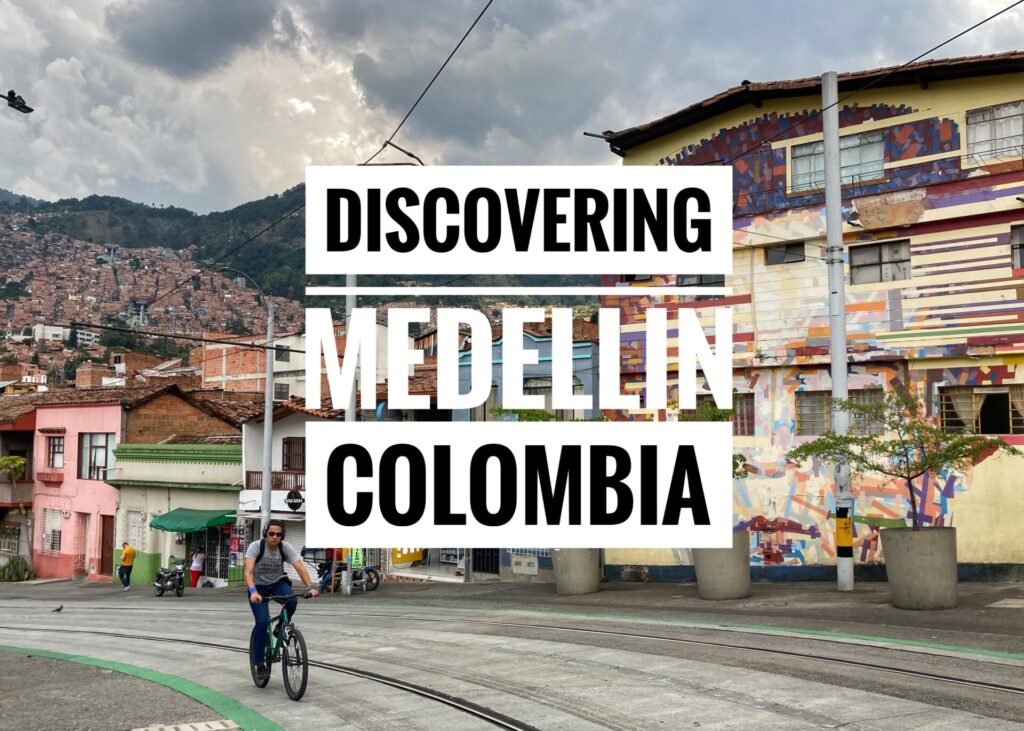
Medellin…to some the mere name of it brings a shudder and a stereotypical statement about cocaine, the TV show Narcos, and the notorious drug lord & narcoterrorist, Pablo Escobar. While it’s true, that Medellin was once known as the “murder capital of the world,” in the last 20 years it has undergone a miraculous transformation and is now a must see on any journey to this part of the world, as well as a significant draw for expats and nomads. It’s truly inspiring and simply incredible how far this city and country have come in such a short time.
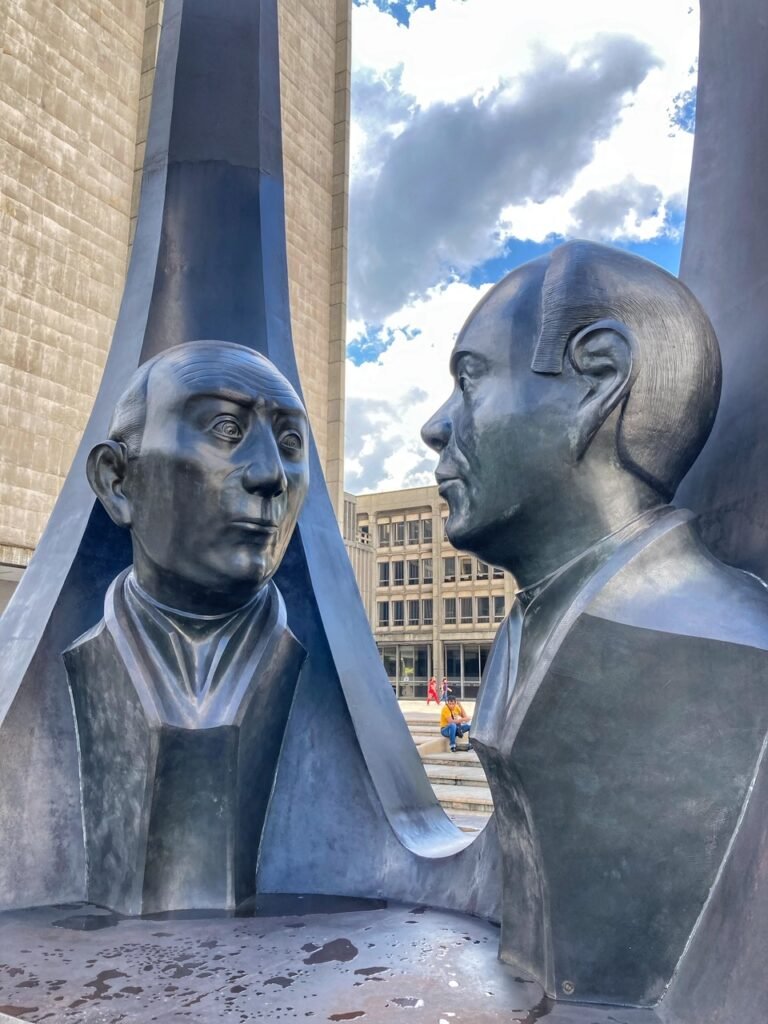
Free Walking Tour from Real City Tours
To ease ourselves in, as we do in most cities, we figured a good place to begin was a free walking tour, which gave us a small dose on the lay of the land. The statue honors former governors of the State of Antioquia, Gilberto Echeverri Mejía and Guillermo Gaviria Correa. They were kidnapped by the FARC (Revolutionary Armed Forces of Colombia) in 2002 during a peace march and gave their lives to promote the culture of nonviolence in Antioquia.
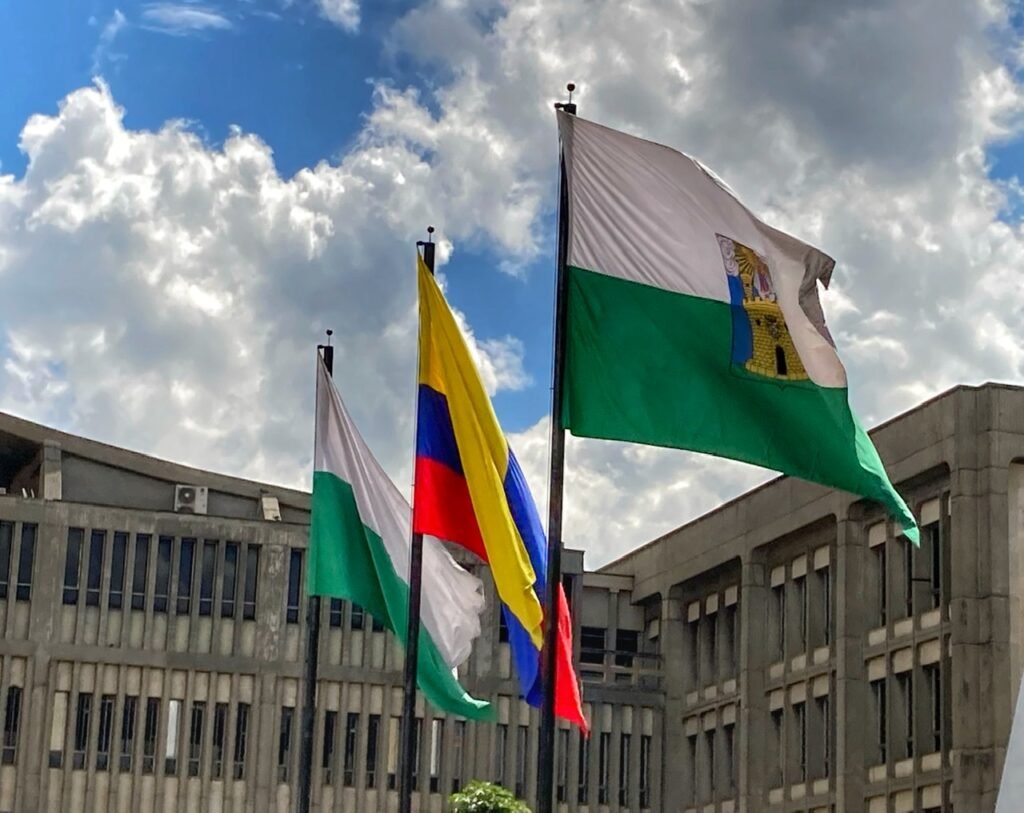
Three important flags:
Left: the flag of Antioquia, the state or department we are in.
Middle: Colombian flag. The colors represent, blood, sea and gold.
Right: Flag of Medellin
We learned that Ecuador and Venezuela’s flags are similar to Colombia’s because at one point they were one country, in addition to Panama and Peru.
This eye-catching sculpture 125 foot tall sculpture is known as Monumento a La Raza and is made of concrete and bronze. The monument symbolizes the culture of Antioquia, including its agriculture, religion, and solidarity. At right, you can see bits of the detail in this photo.
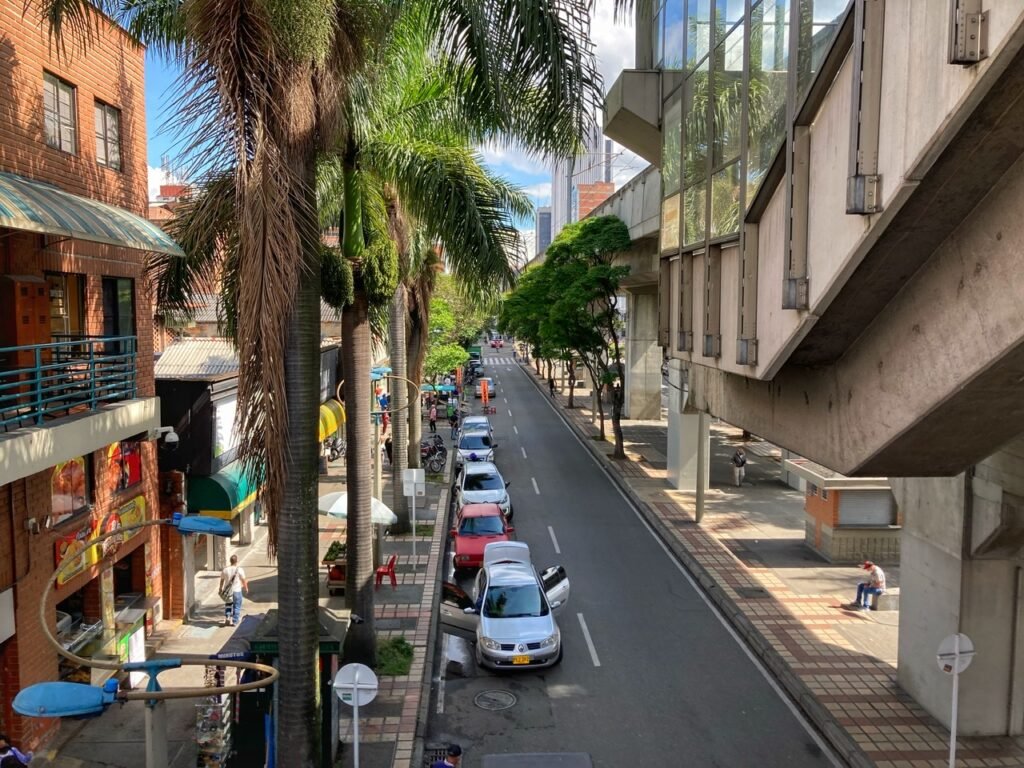
A street near el centro by the metro.
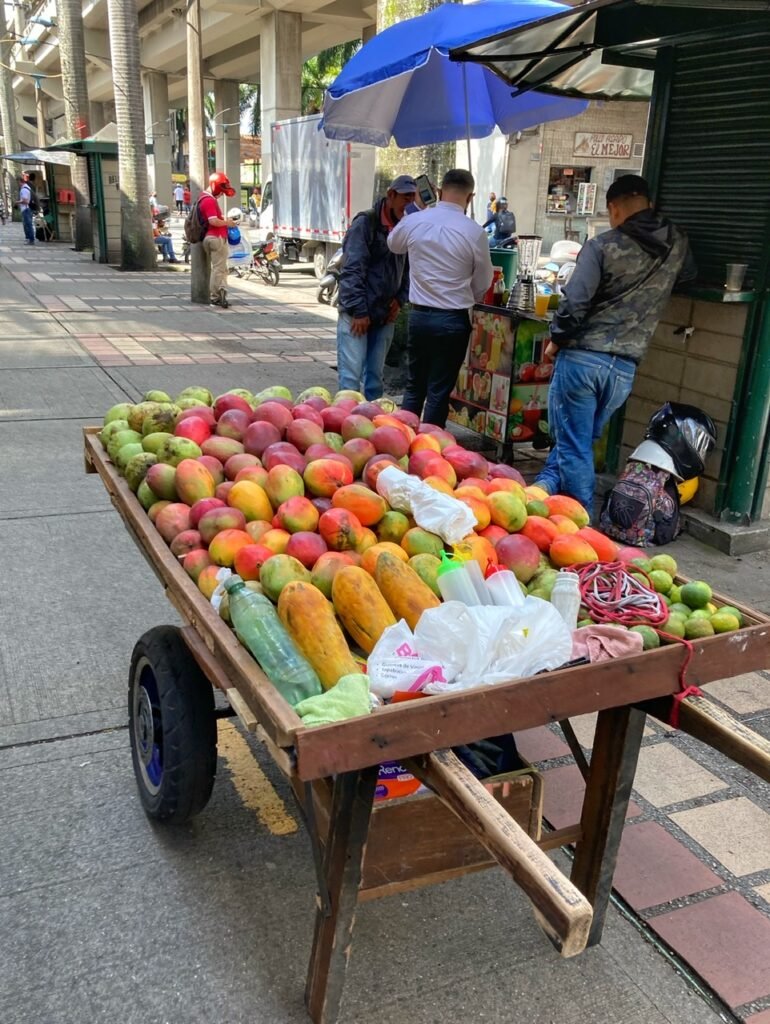
A cart of complete yumminess. Papayas cost about $1.
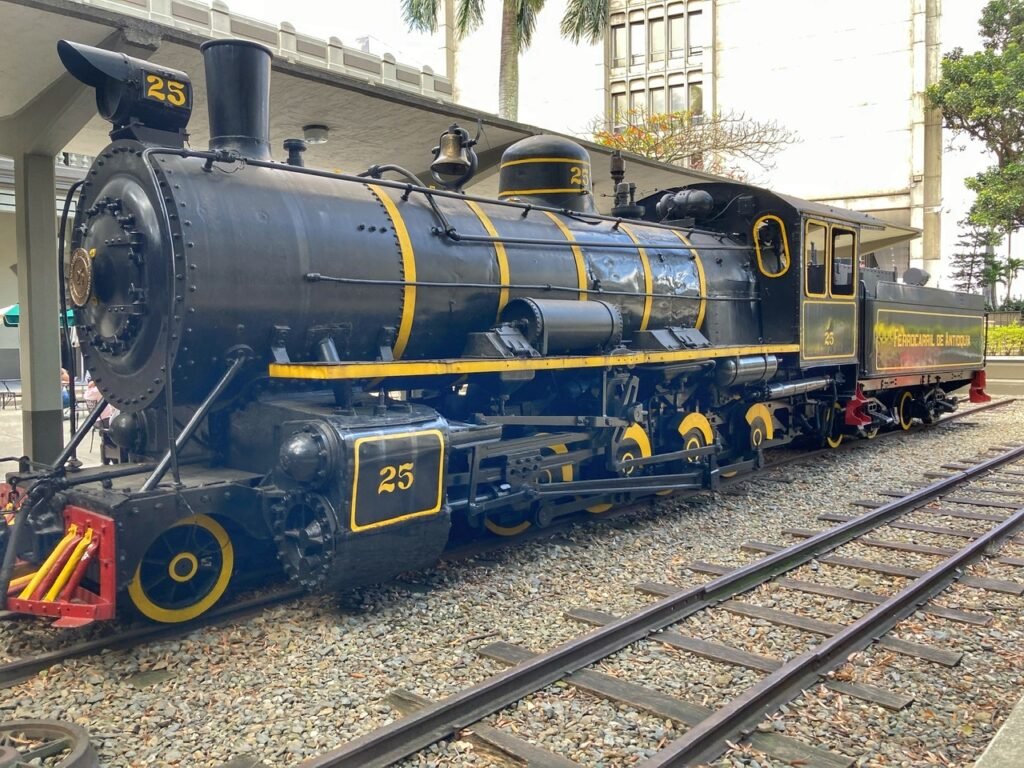
The old railway station of Antioquia (this is the department, or state Medellin is in), was declared a national monument in 1996 for its historical value to the city and the country. The advent of the railroad connect Antioquia with the rest of Colombia, but also helped the Colombian economy to grow exponentially. However, like in the States, the advent of road networks, unfortunately fossilized the rail network.

The building is French Renaissance in design.
Next door is Las Luces Park, or Plaza Cisneros, which features a bunch of gaudy white sticks protruding into the sky. Well, apparently at night, these sticks become a forest of light sabers and are a lot less gaudy. Unfortunately, our guide advised us not to visit this area after dark which kinda eliminates the fun. She added, “It’s still a heck of a lot safer now than it was 40 years ago when a lot of bad stuff happened here.”
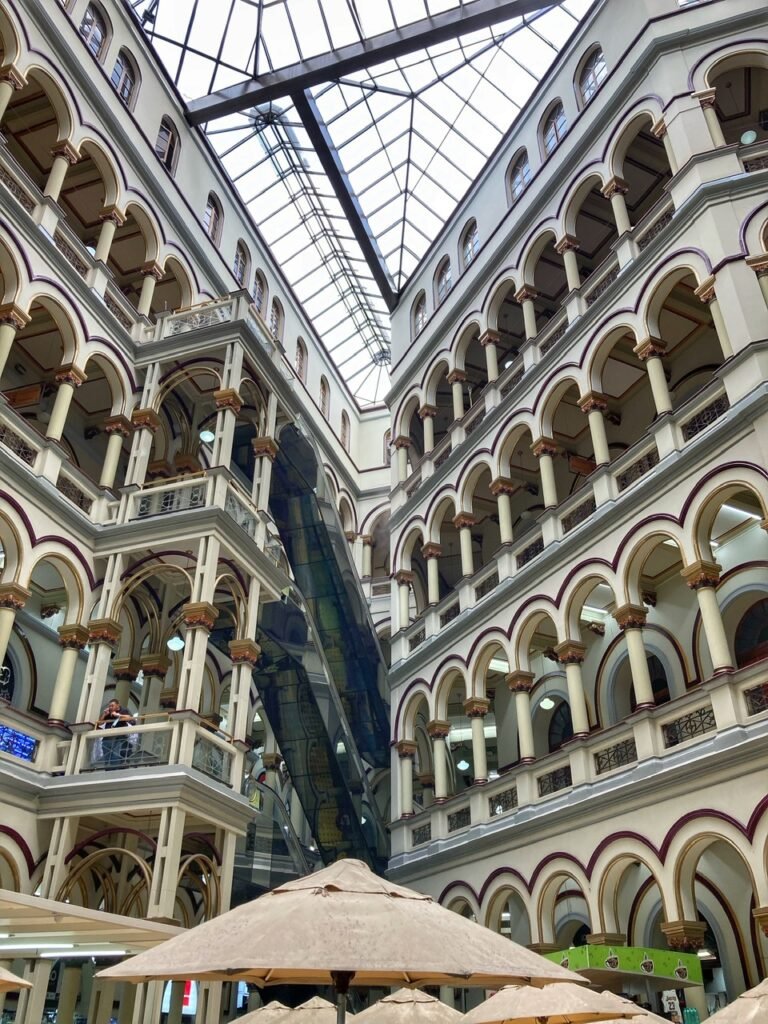
The National Palace Mall is a three story former government building which has reidentified itself as a stunning place to browse hundreds of (mostly) knock-off shoes. And, they expect you to negotiate!
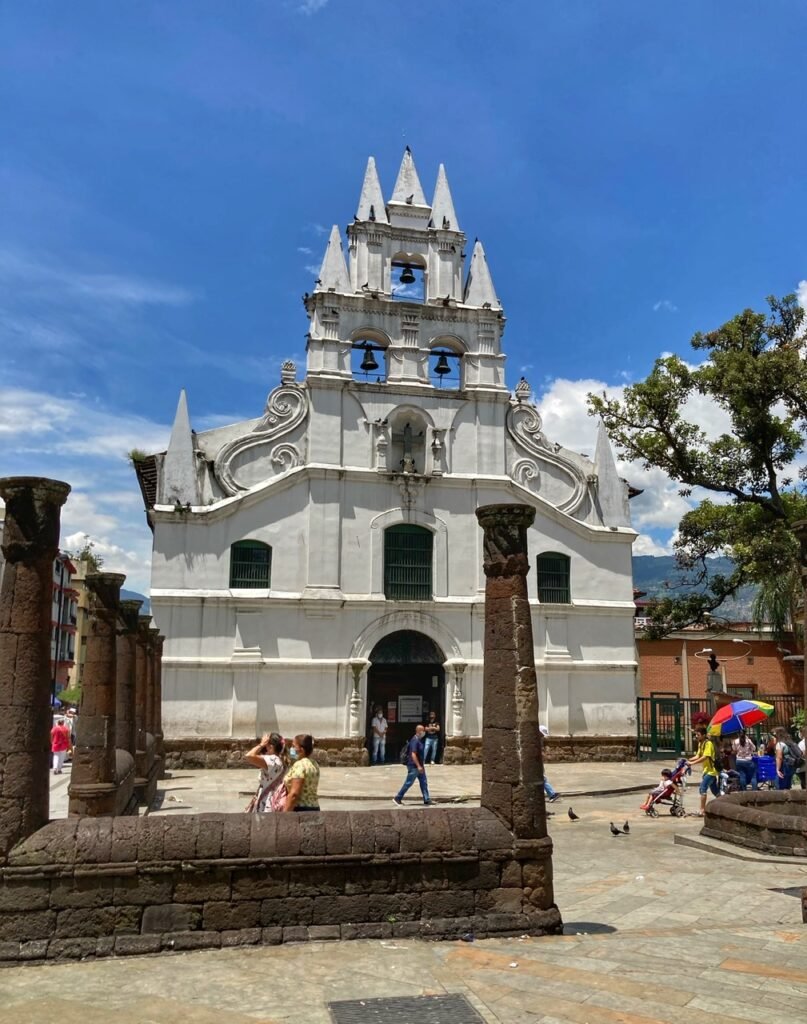
The second oldest church in Medellin is sadly also the site of a lot of prostitution, no matter the time of day. Sin and repent, sin and repent. Quite the vicious cycle. Prostitution, it turns out, is legal in Colombia although being a pimp is not, which at least is a better scenario. Many prostitutes in Medellin are now unfortunately refugees from Venezuela.
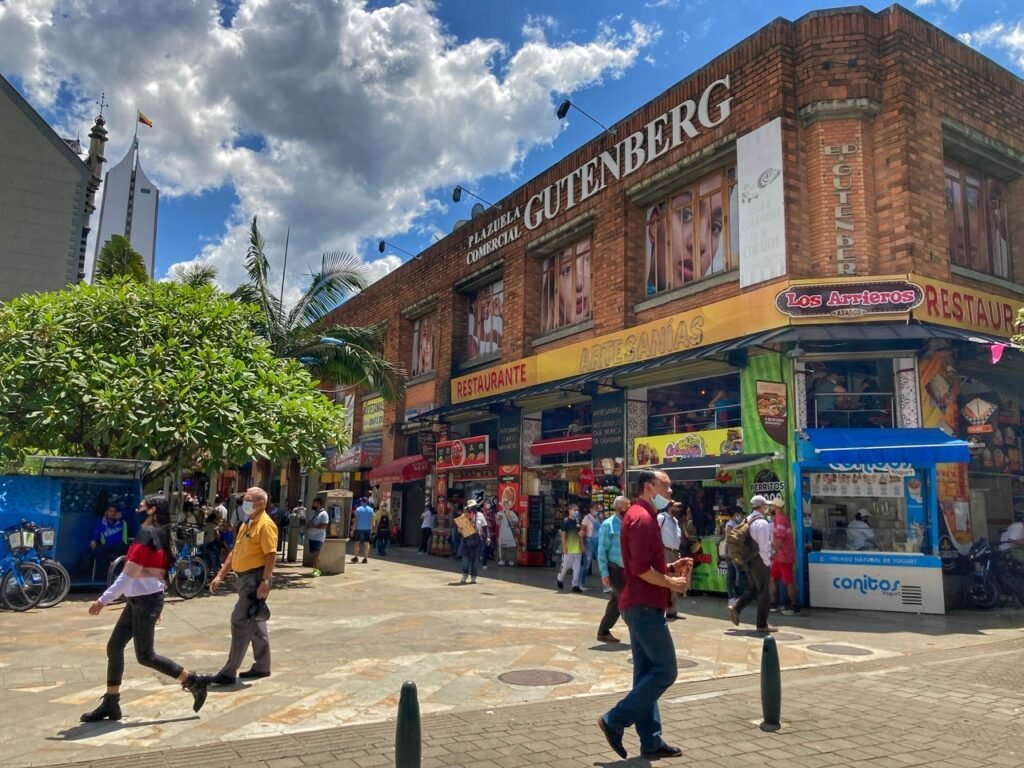
Street scene near Botero Square. Who’s Botero?

Born in Medellin in 1932 (and still kicking), Botero (not actually his likeness) is the most famous living artist in Colombian history, and one of the most in Latin America. His signature style is “Boterismo” depicting people and figures in large exaggerated volume.
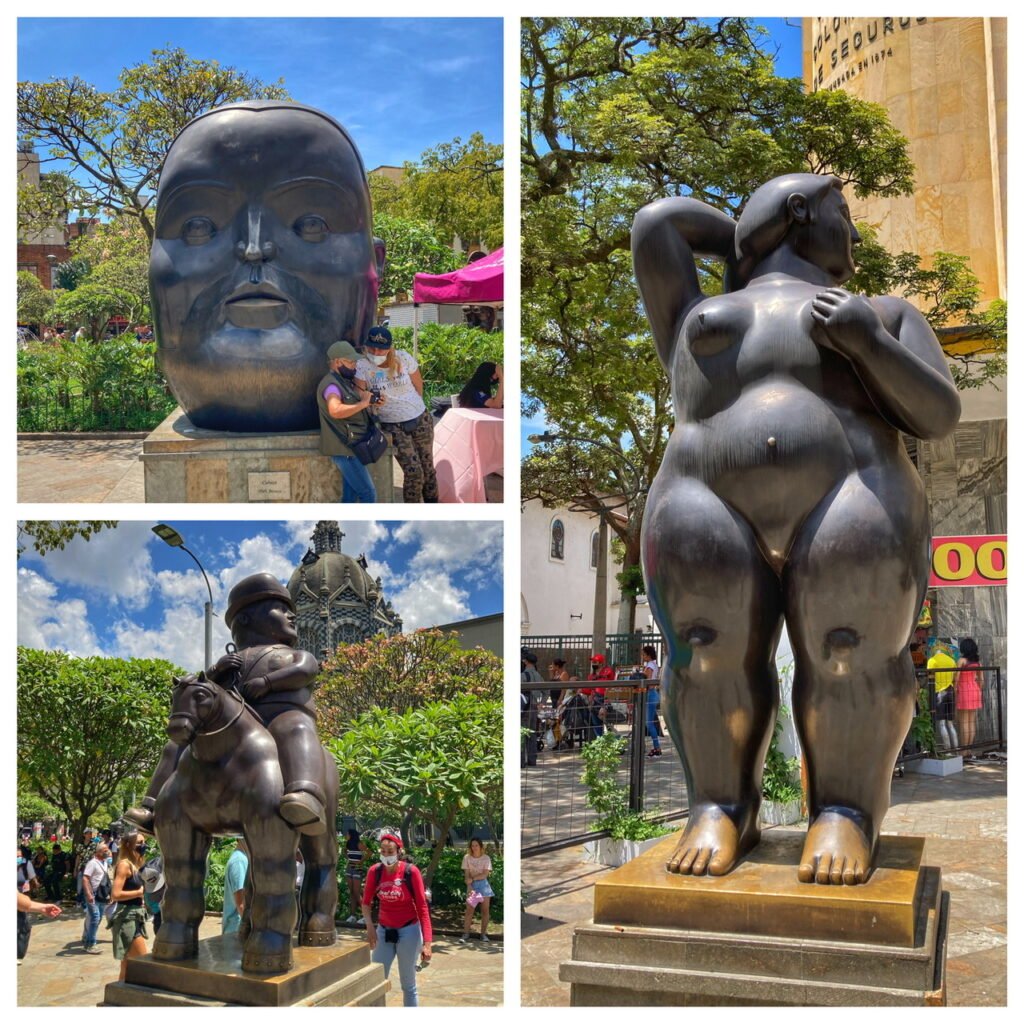
Botero Square? You guessed it. Site of many Botero statues. 23 in fact!! And they are all originals donated by Botero to the city of Medellin.

You know it’s an original if it has his signature and the foundry mark on the back.
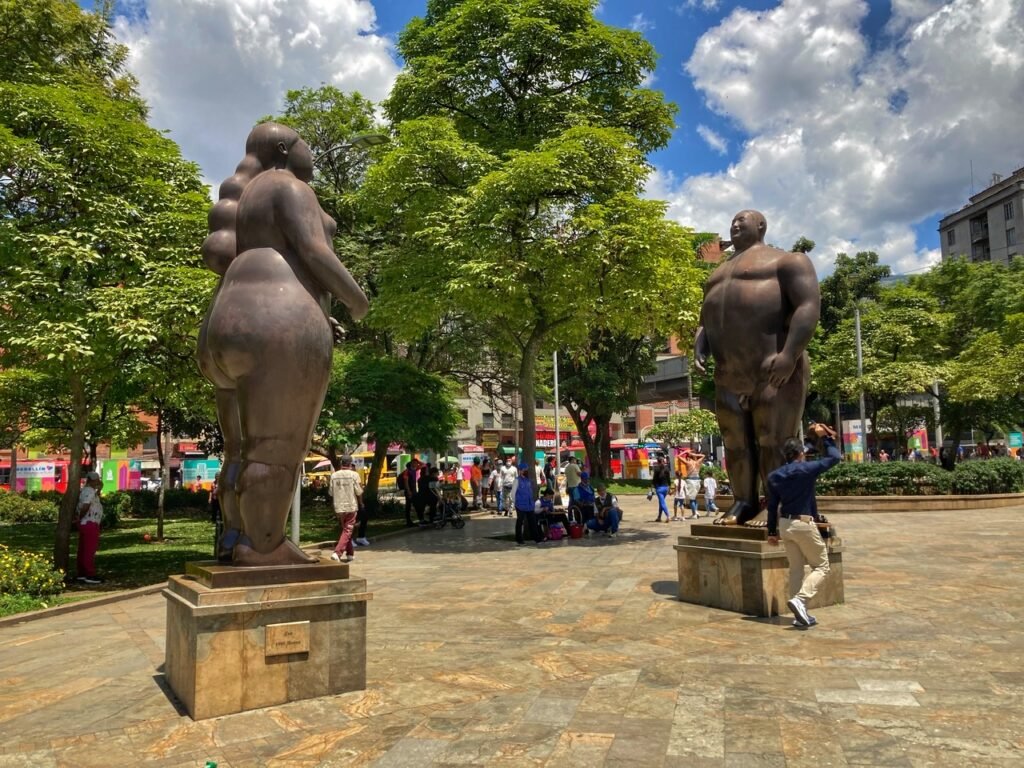
This one is called Adam and Eve. Wow! Adam has a very tiny….never mind….
Botero statues are also found in Berlin, Singapore, Yerevan, Jerusalem, Paris and New York among other places throughout the world. His paintings sell for up to $2 million. He now spends most of his time in Paris but lives in Medellin at least a month every year. Wonder which one he chooses since they’re all beautiful.

A chubby Botero kitty stands proud next to a beautiful building that is NOT a church even though it appears to be one.

In fact, it’s the Palace of Culture Rafael Uribe or the cultural arts center.
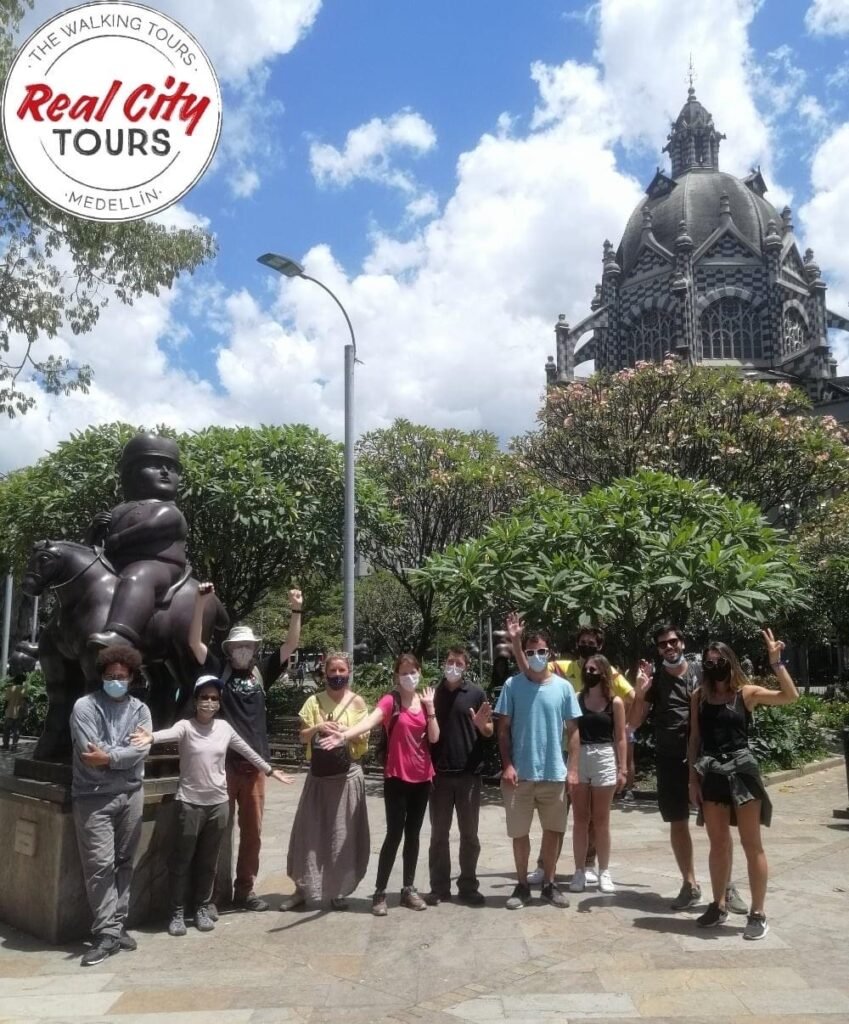
Our tour group consisted of people from France, US, Portugal, Canada and Czech Republic. No shortage of travelers in this city!
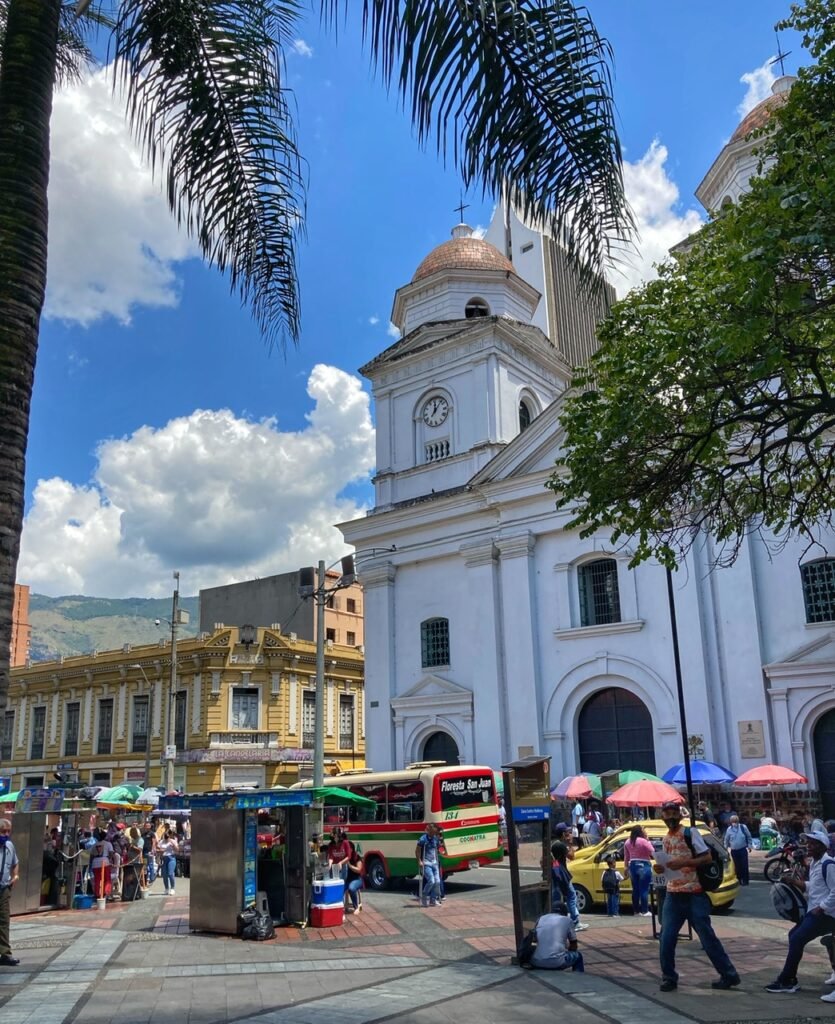
The first oldest church in Medellin, with a history spanning back to 1649.
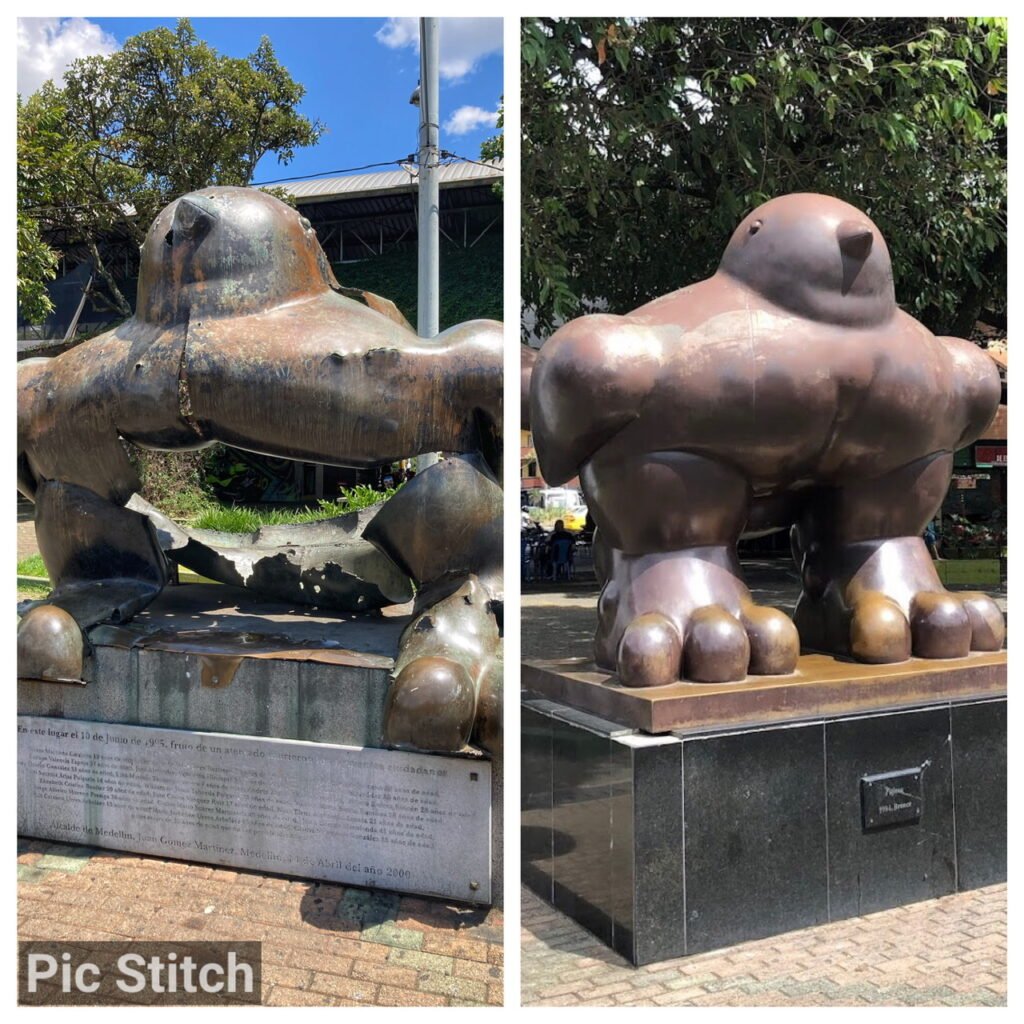
More Boteros. This time a pair of vastly different birds in Plaza San Antonio. The birds are actually the same, except one is completely intact, while the other has a hole through its middle and shrapnel marks all over. The original bird was destroyed by explosives placed at the foot on the statue in 1995 during a public concert. 30 people died in the bombing, and another 200 were injured. Rather than remove the bird, Botero donated an identical one and insisted the two stand side-by-side. Today, the structures are known as the Birds of Peace, and are a stark reminder of Medellín’s ability to heal, but not forget.
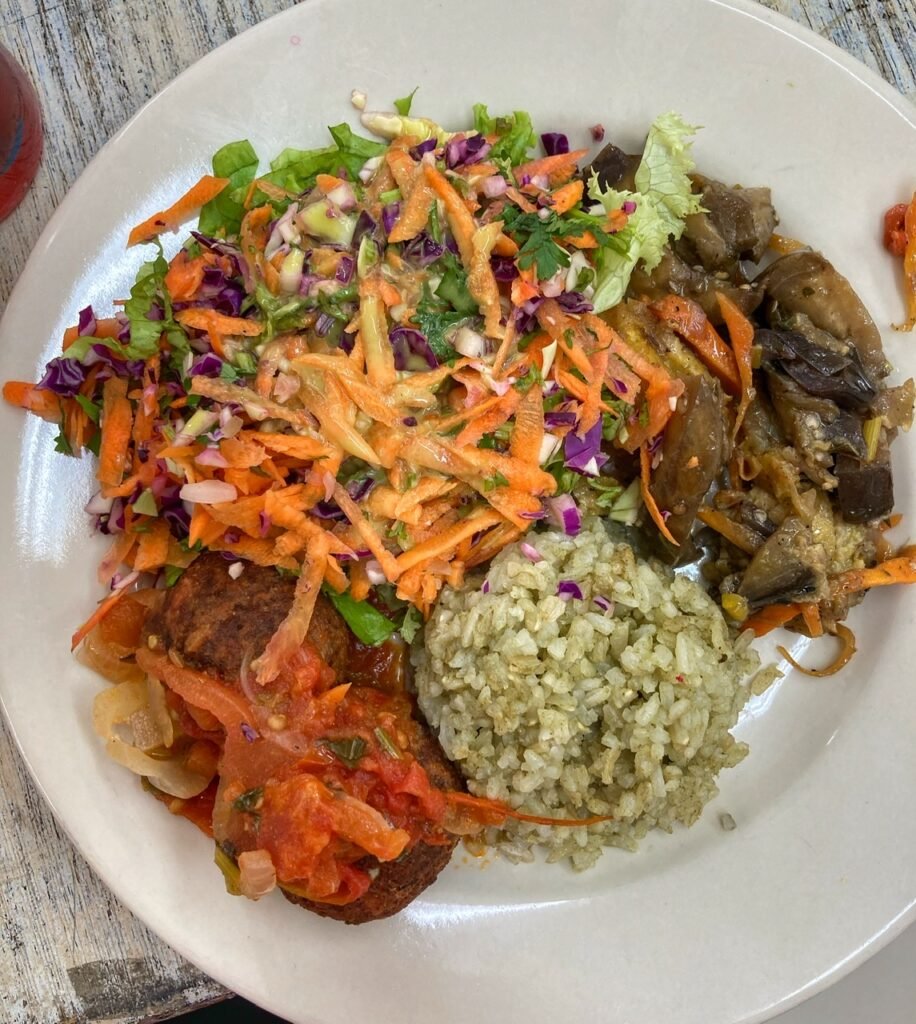
After our tour, we had lunch with a Portuguese and American couple at an amazing vegetarian restaurant called The Veggie Life. As everywhere in Medellin, they offered a Menu del Dia and it was phenomenal with all this vegetarian goodness, as well as a soup and juice, for about $3.50. Absolutely delicious.
On the way back to our apartment in Envigado. Medellin has an integrated Euro-quality metro, tram and cable car system, which we are excited to move about in. Metro rides cost $.69 each, but we bought a Civica card for the time we were there with multiple rides. Here is an easy guide on how to use public transportation in Medellin.
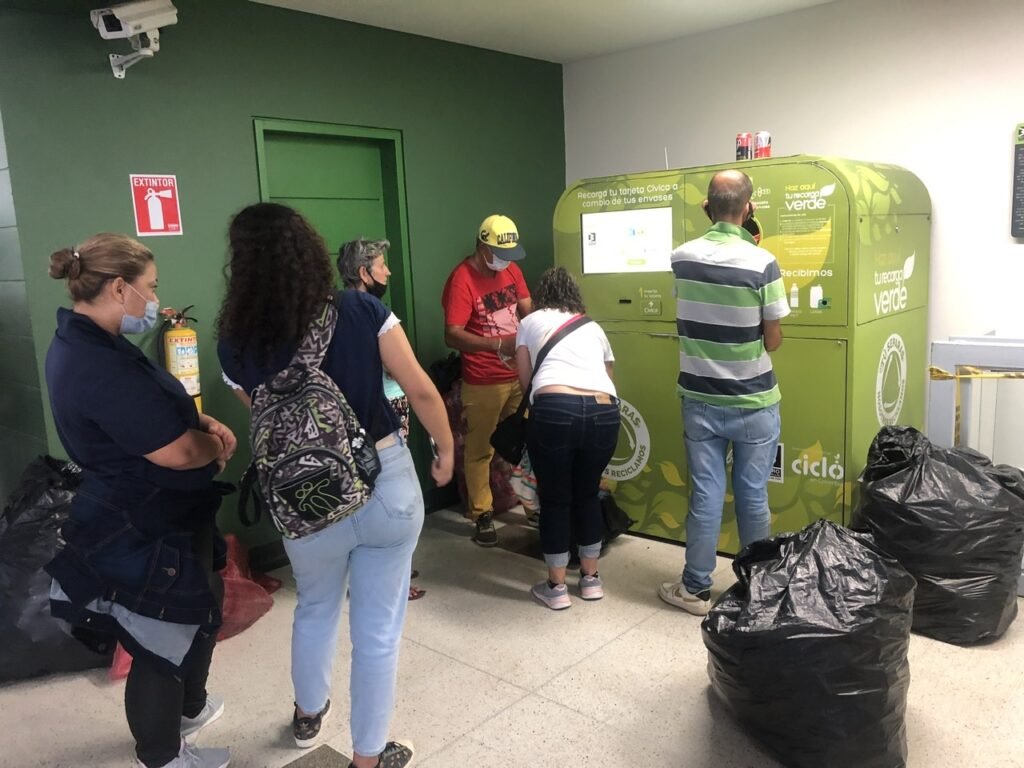
A couple of other observations in the Medellin transport system:
We knew they had these in Asia and in some places in Europe, but we were absolutely thrilled to see them in Colombia. Not familiar with what is going on? It’s a machine that gives you public transportation credit in exchange for your recyclables. What a brilliant win-win for the planet!
We have also been pretty impressed to see how Medellin is handling COVID. Nearly everyone follows the mandate of wearing masks and they even offer vaccine clinics, and vending machines with masks and sanitizer in the metro stations.
Jardin Circunvalar & Museo Casa de la Memoria

On another day, we headed up…and up…and up into the hills of Medellin via metro cable car to get a birds eye perspective of the city, check out the Jardin Circunvalar, and the “average” neighborhood of Los Mangos. We also paid an obligatory visit to the Memory House Museum to get a dose of Medellin history and had another terrific Menu del Dia for $3/each.
To get to Jardin Circunvalar from Envigado, it required 50 minutes and three transfers from the metro, to the tram to the cable car, all together which cost an astounding $.69/each. You will know you’re in the right place when you see “Jardin” scribbled into the hillside like the Hollywood sign.
Starting the journey upward. It was interesting to check out the alleyways and endless staircases underneath us as we rose.
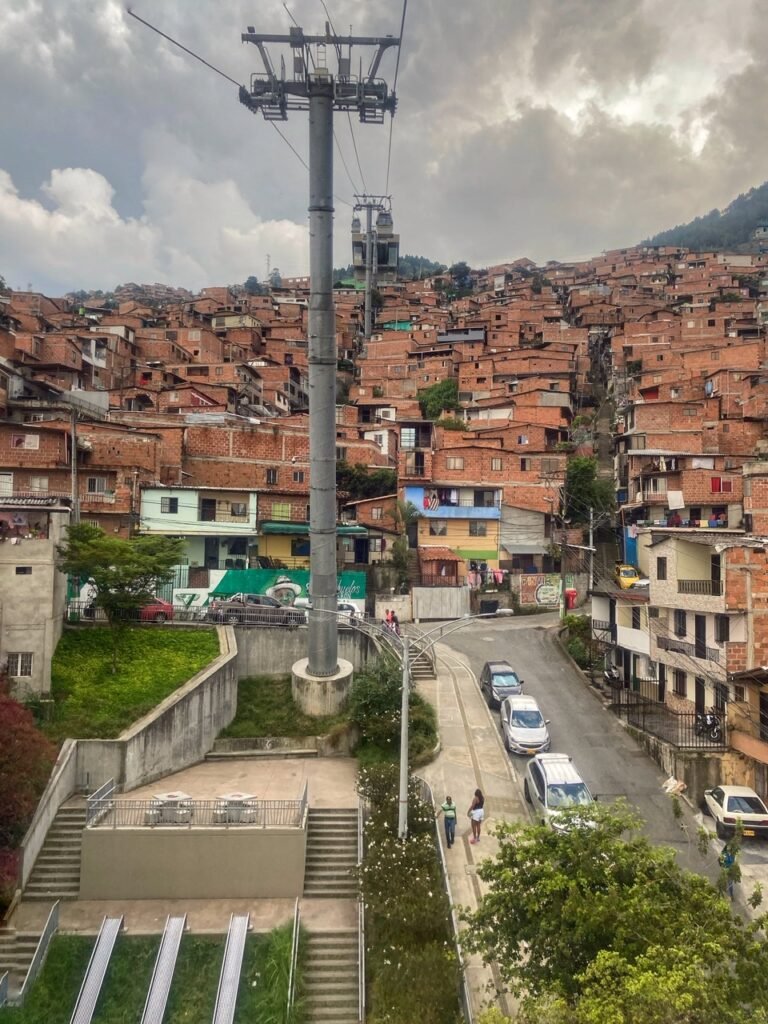
The way the city is built, basically in a massive bowl, reminded us a lot of Guanajuato, Mexico but without the bursts of color.

We were actually surprised to see so much brick, and little stucco or paint at all.
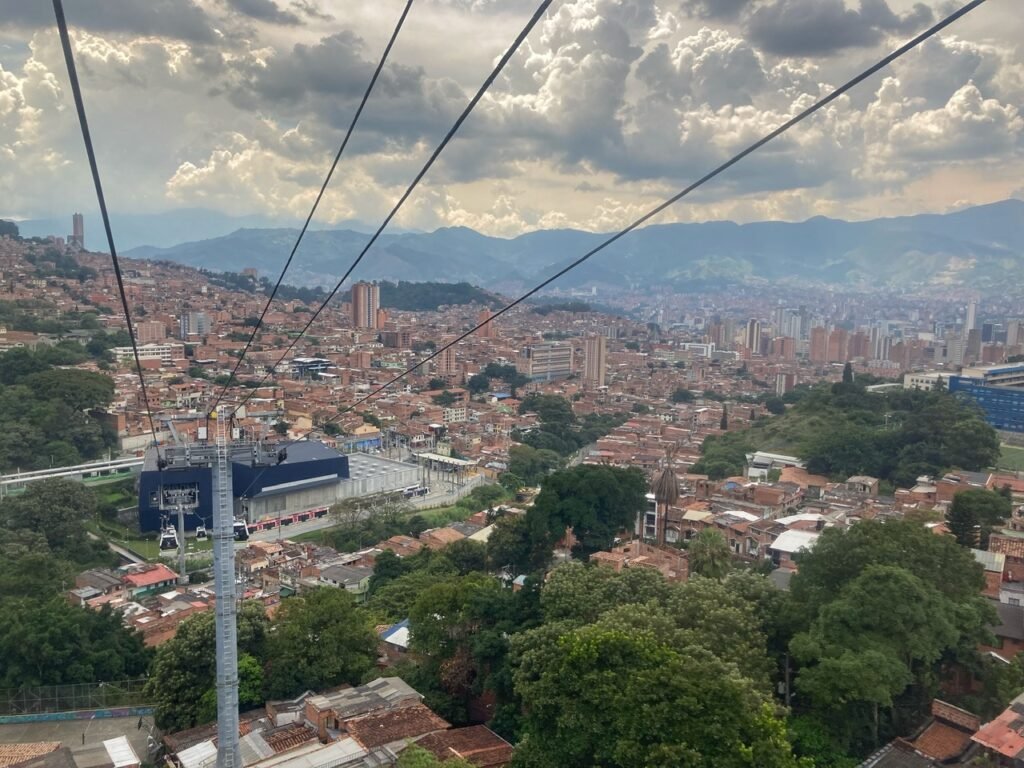
Looking down into the valley. Pollution and not too wonderful air quality are definitely a downside of living in Medellin and it is ranked #9 as most polluted cities and towns in Latin America. It never felt oppressive by any means but we certainly don’t mind wearing a mask for more than one reason.

Arriving to the top. The view from the park looking down. The air definitely felt fresher up there. We do love how green this city feels after some of our experiences in Mexico.

The streets are insanely steep. We can’t imagine how these people used to manage before the metro cable was installed. This undoubtedly enhanced their lifestyles significantly.
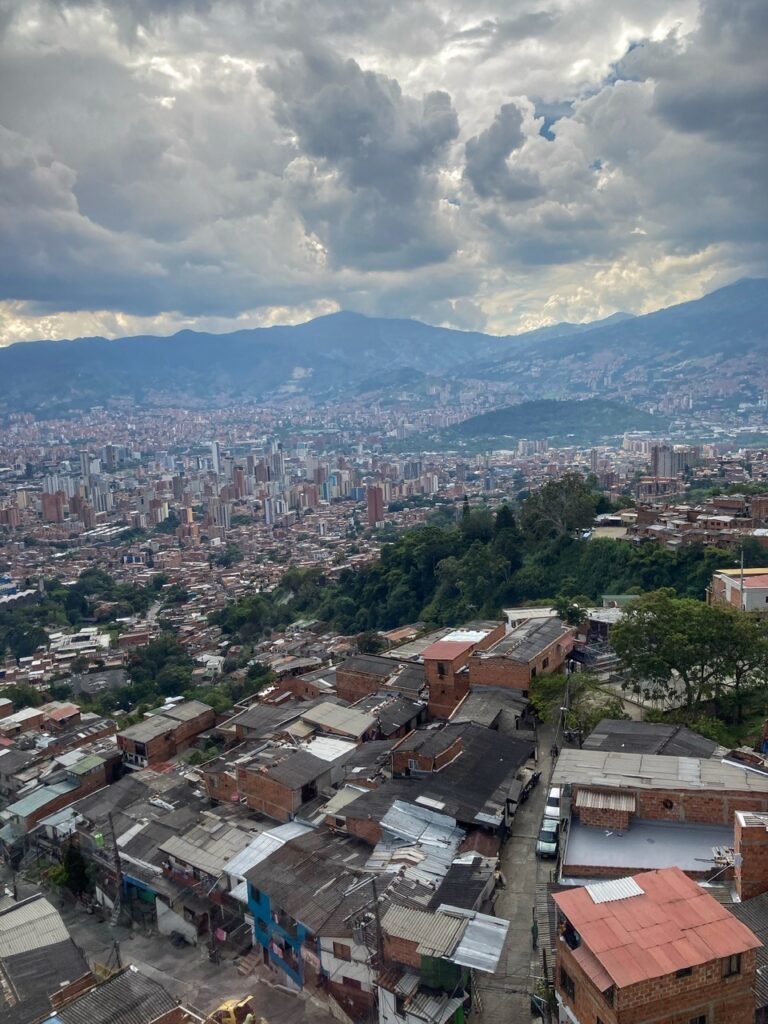
It feels like a city of 4 million from up here for sure.
Some of the houses below in the San Antonio neighborhood. The population living below the poverty line is 34% in Colombia. Though the economic growth of Colombia is among one of the world’s emerging economies, more than three out of ten Colombians still live in poor conditions. Colombia is also the world’s seventh most inequitable country. https://borgenproject.org/
Walking along the tram line to check out the Caicedo neighborhood. The Euro-style tram interestingly ran on wheels, not rails.
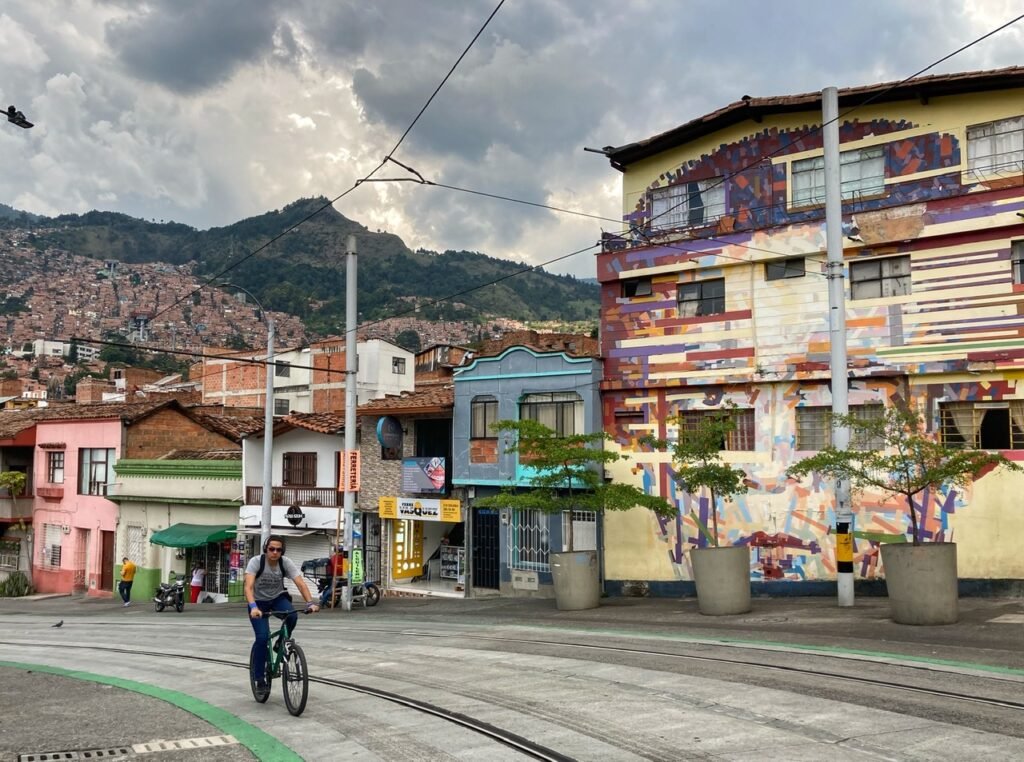
A colorful facade near the Bicentario tram stop.

The Museo Casa de la Memoria was a free museum which offered solemn exhibits on the history of Colombian wars and armed conflict. It was definitely a good place to understand some of the struggles that Colombia has gone through, but felt a little underwhelming and discombobulated without an obvious flow, but this is perhaps because our Spanish is not super strong. However, we were very glad to see several school groups there learning about the conflicts, especially after we had learned from our guide that dishearteningly school children are not taught about this in school. Very tragic.

Lunch! Menu del Dia included all this plus soup for $3/each. We’re obsessed!
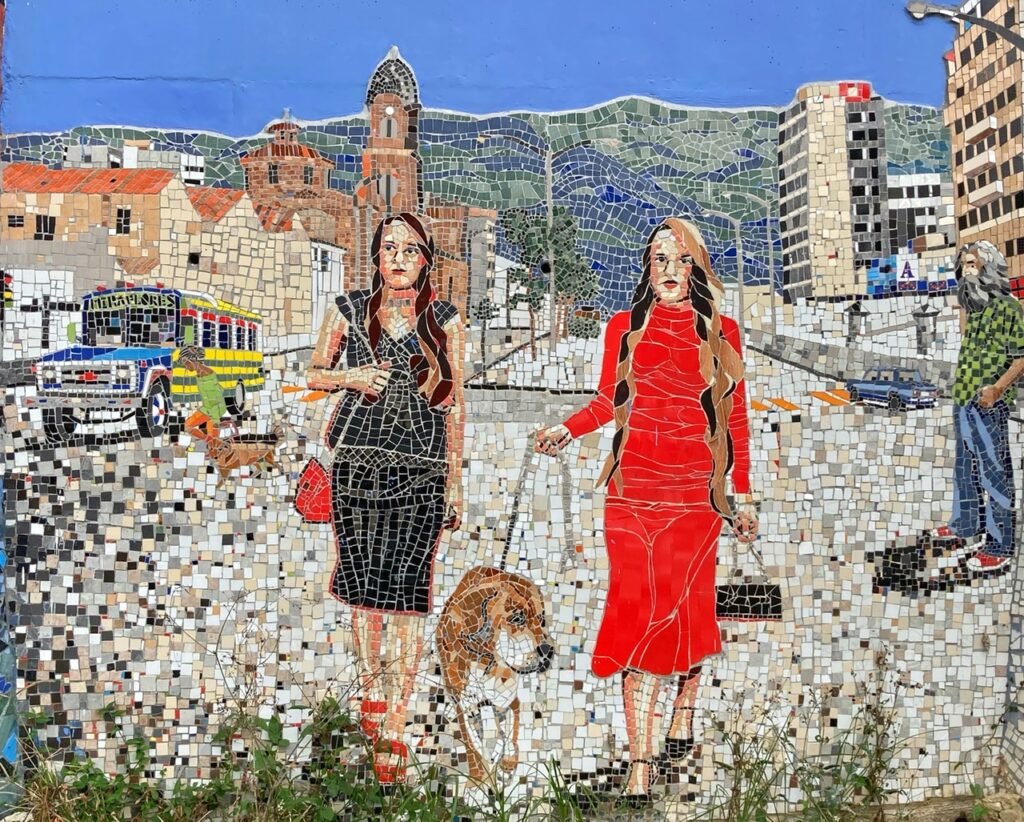
A gorgeous mosaic mural that covered the side of a whole building. Everyone seems to have a dog here, so that’s a pretty accurate depiction.
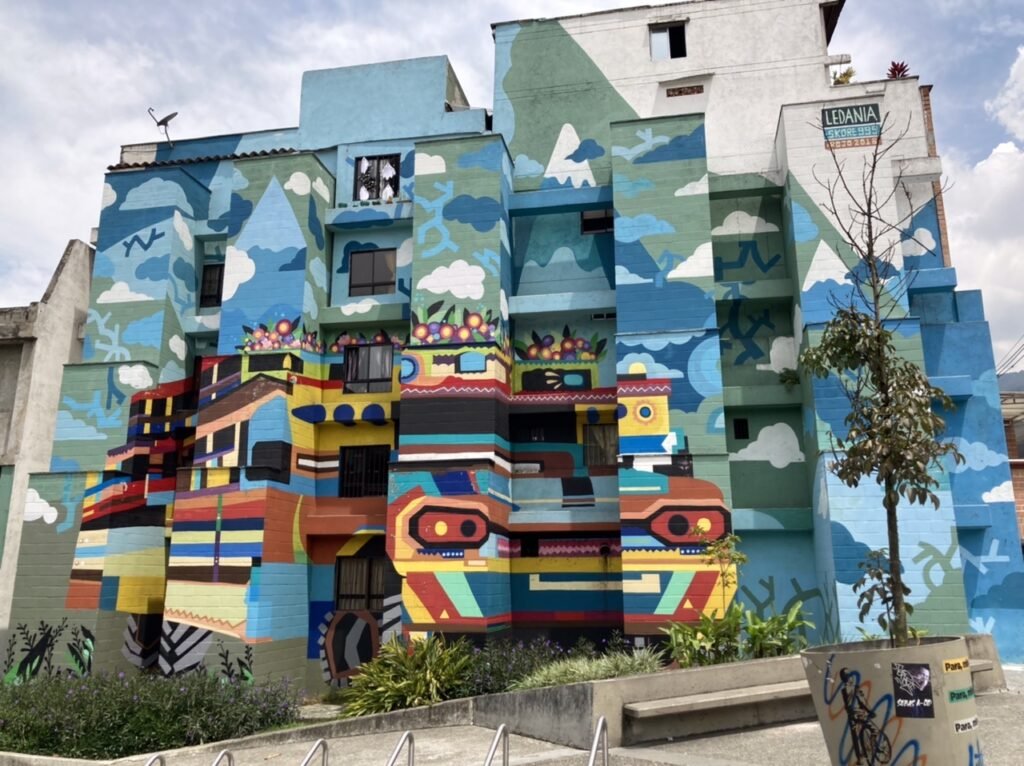
Loved how this mural covered the side of a building. We didn’t realize it’s actually a bus until reviewing the photo later.
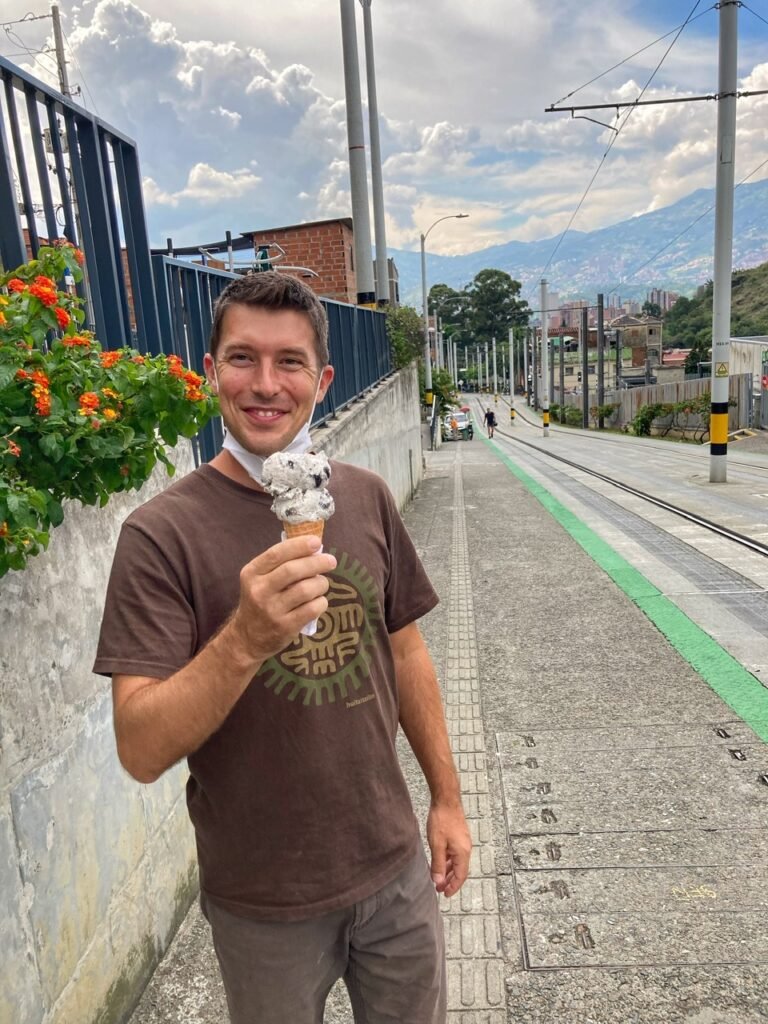
Greg is happy. Ice cream costs $.80 for two scoops of “Brownie” ice cream. The “brownie” he asked for was actually cookies and cream, but he choked it down.

Jardin Botanico (Botanical Garden of Medellin)
On another day, we ventured to the Botanical Garden of Medellin, which is a 14-hectare green wonderland in the heart of the city boasting more than 4500 flowers and 139 recorded bird species. It also includes a tropical forest, small lake, desert garden, butterfly house and loads of lovely walking trails. And the icing on the cake? It’s completely free, which made it a great afternoon of exploration for us. (Note: we used an app called Leaf Snap quite a bit in this post to identify what plants and flowers we were looking at! It’s so much fun and very easy to use!)
Not exactly sure what this gorgeous sunburst is, but it looks kinda like the flower of a Panama Flame Tree, minus the inner bit which looks a bit like baby birds popping out from a nest.
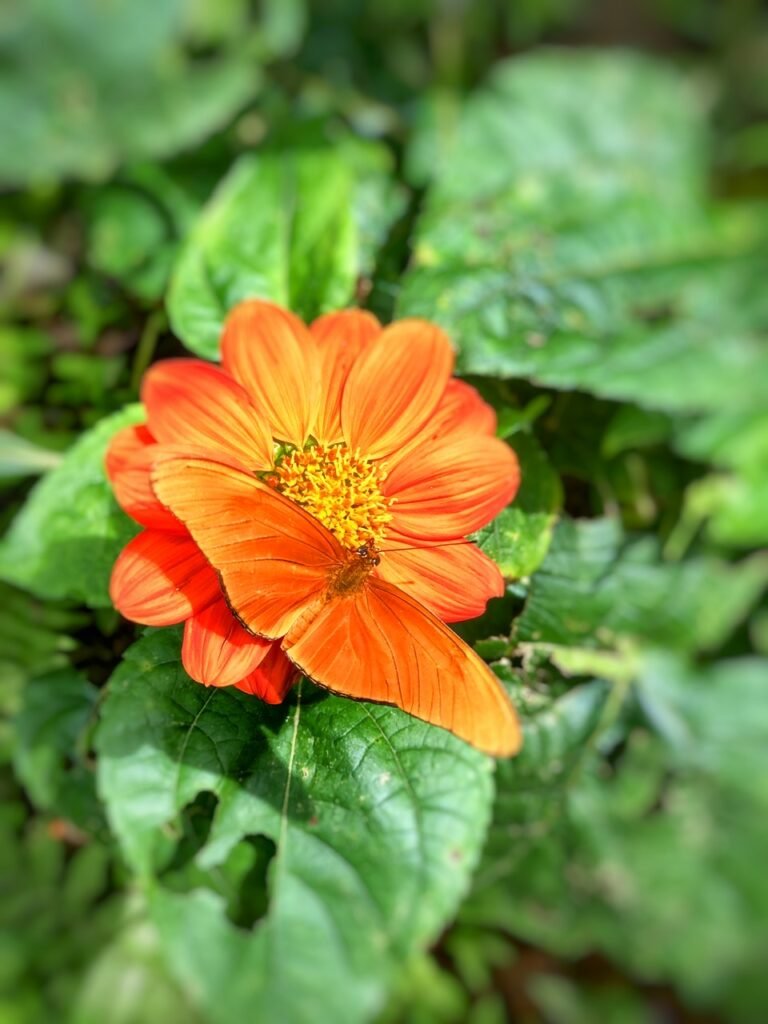
It’s almost easy to miss, huh?
A Brazilian Walking Iris. Seemed pretty immobile to us…but apparently it’s called this because it spreads quite easily.
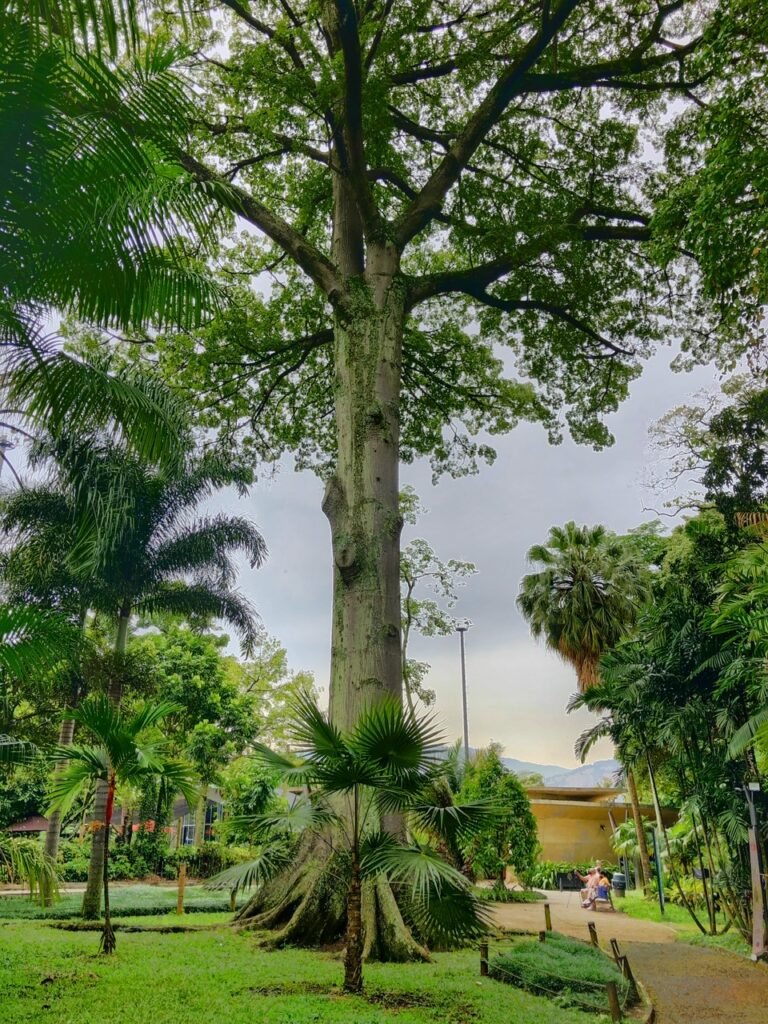
The sacred Ceiba tree is a link to two worlds, at least to the Mayans. They believe the souls of the dead ascend to the top of the trees on their way to heaven…and the roots represent the underworld. It is found is subtropical and tropical regions of the world.
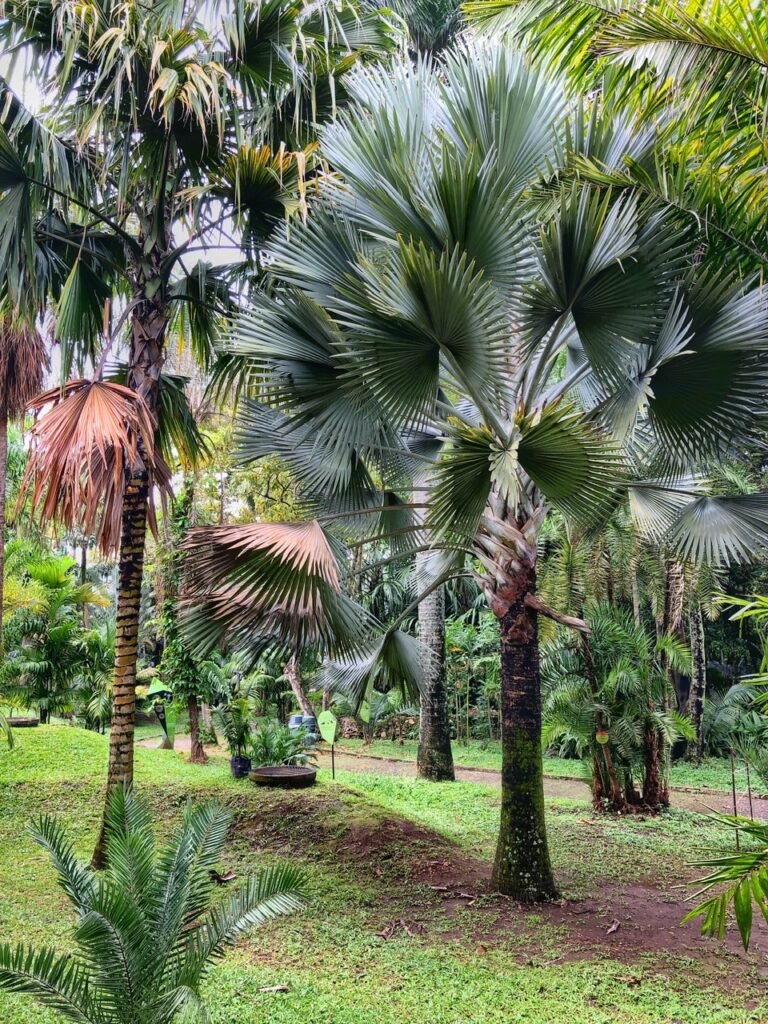
Seems to be a type of fan palm. Unfortunately, most weren’t labeled, which is a little unusual for a Botanical Garden. Must be why it’s free ?
We were lucky to get to participate in an Environmental Festival, which hosted many green and organic-friendly booths and exhibits.
One enthusiastic indigenous lady was very excited to sing the praises of organic produce grown in the Andes and who produced everything by hand. She also went on a Span-rant about how kids these days won’t get off their phones and “learn about traditions.” Ha. We had to buy one, which was a dessert made of grated chayote (type of squash), raisins, condensed milk and cinnamon. All natural and really delicious.

The Calabash gourd trees grows fruits that aren’t edible to humans, but are used for a variety of ornamental purposes like musical instruments, bowls, and cups.
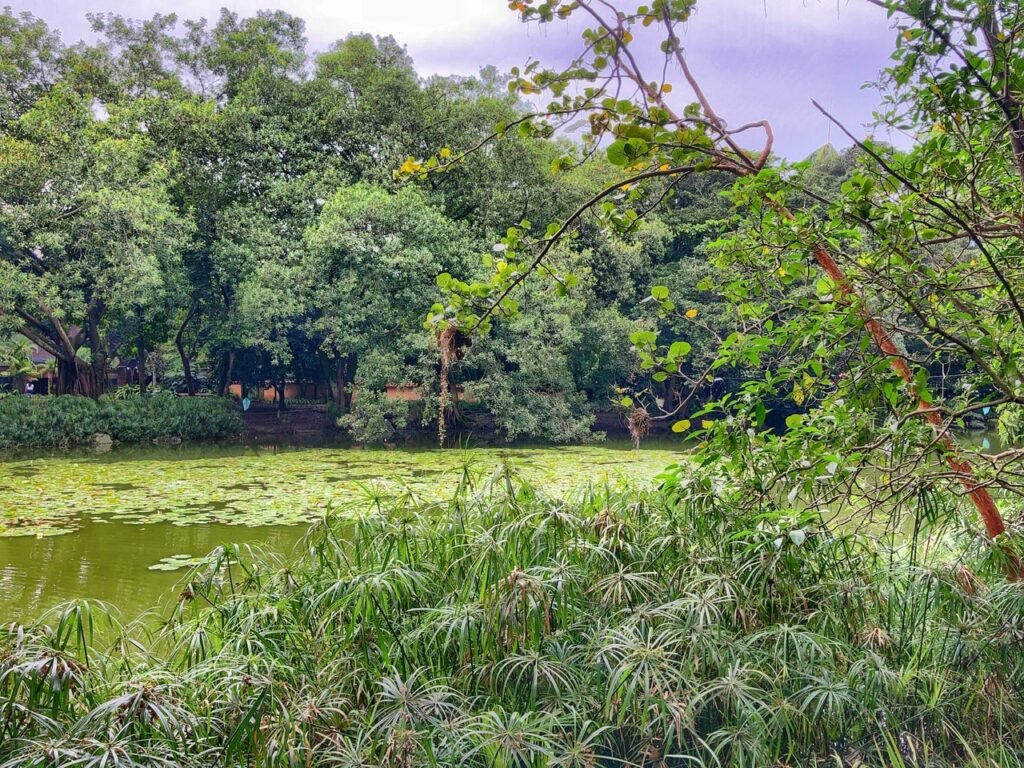
The lovely lake within the botanical garden. Can’t believe no one has capitalized on this by throwing in a bunch of swan boats.
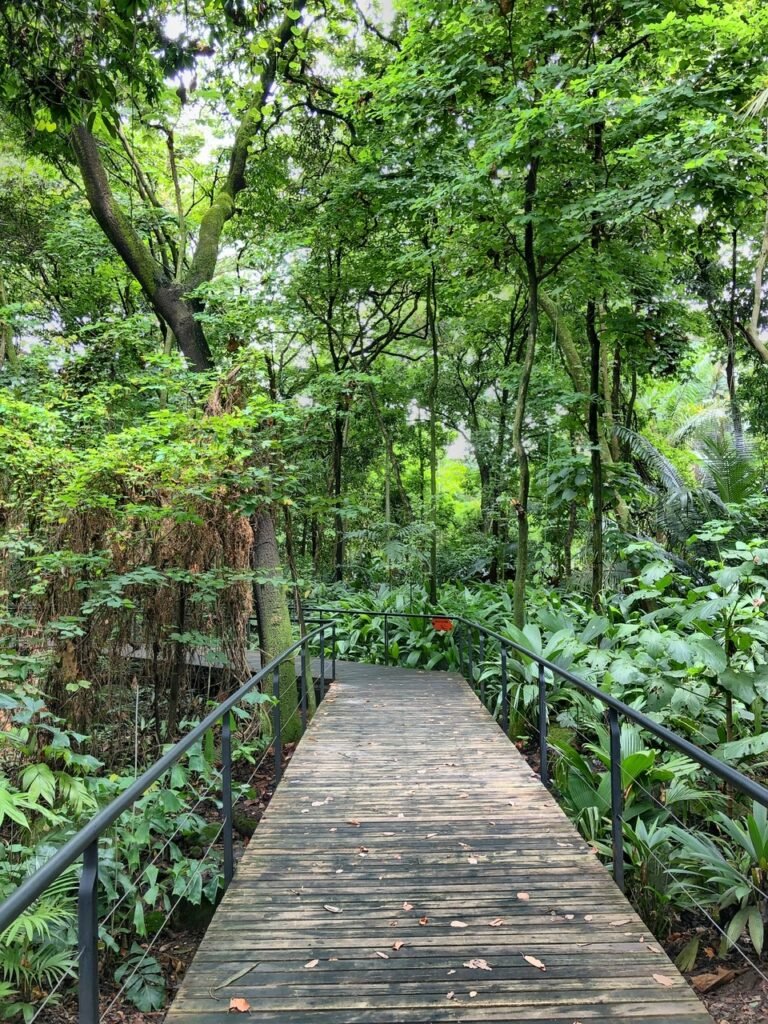
A walkway into the tropical forest.
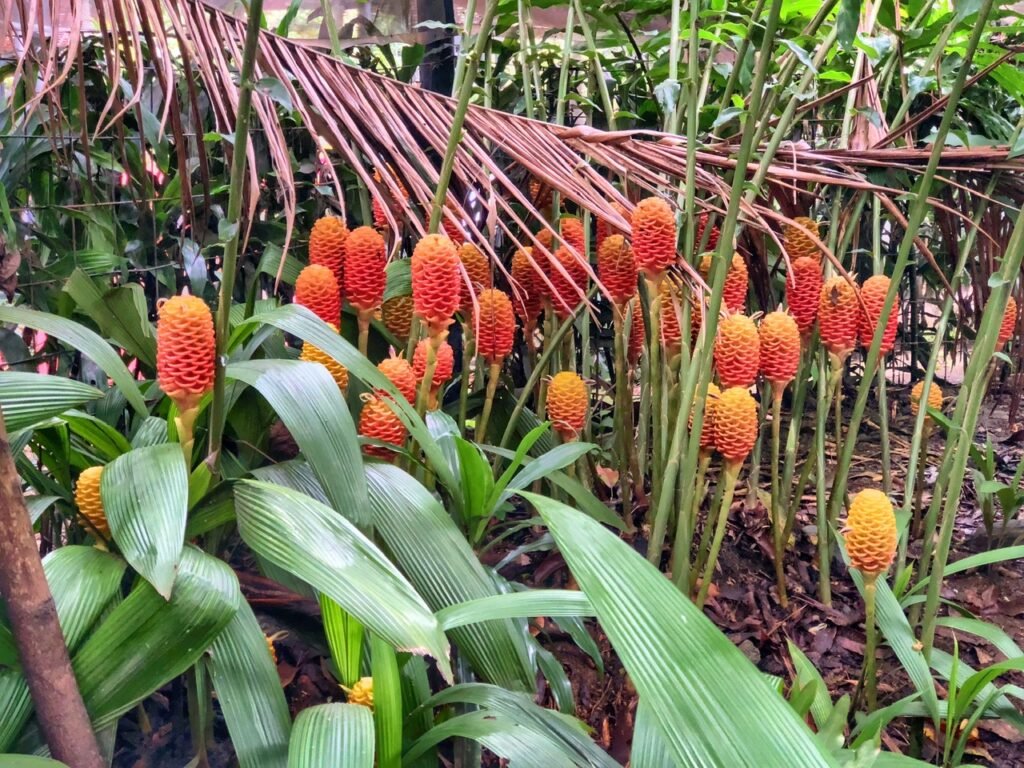
Beehive Ginger is a stunning ornamental plant that is obviously named after the distinct floral form that resembles a beehive.
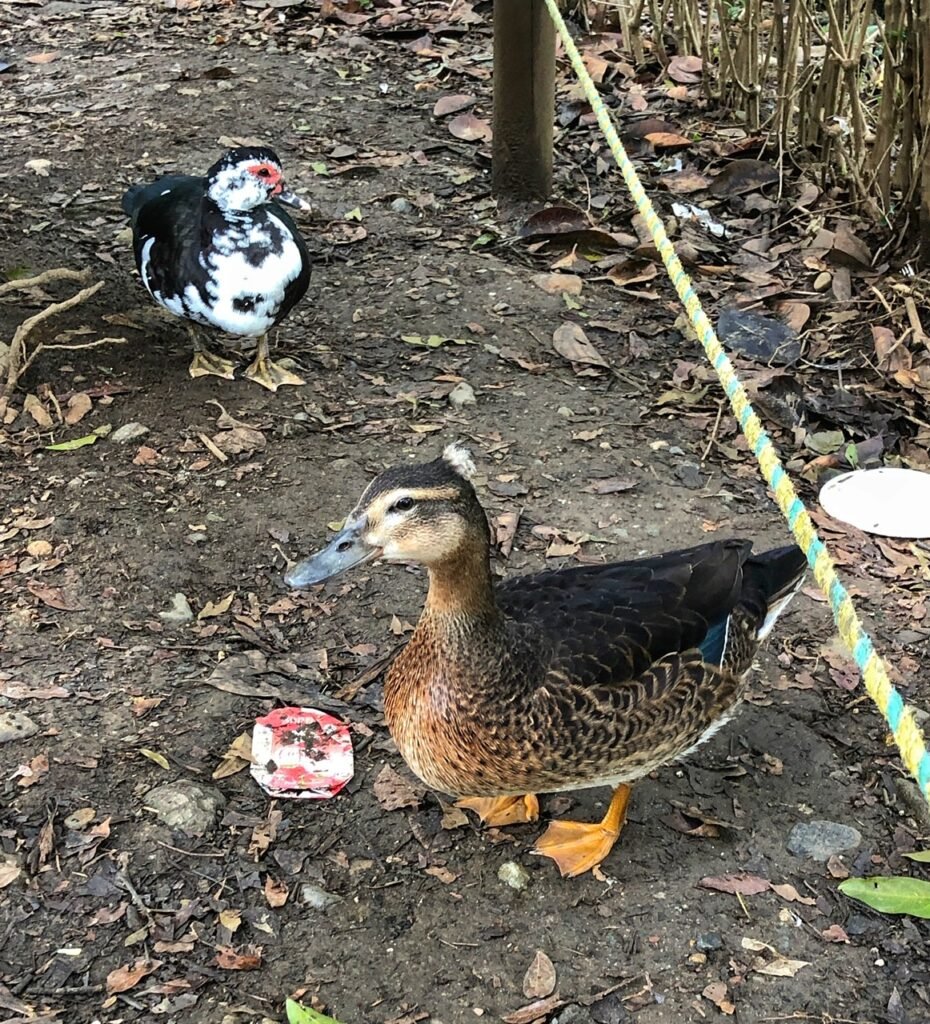
They have different kind of ducks in Colombia. This one seems oblivious to his bad hair day.
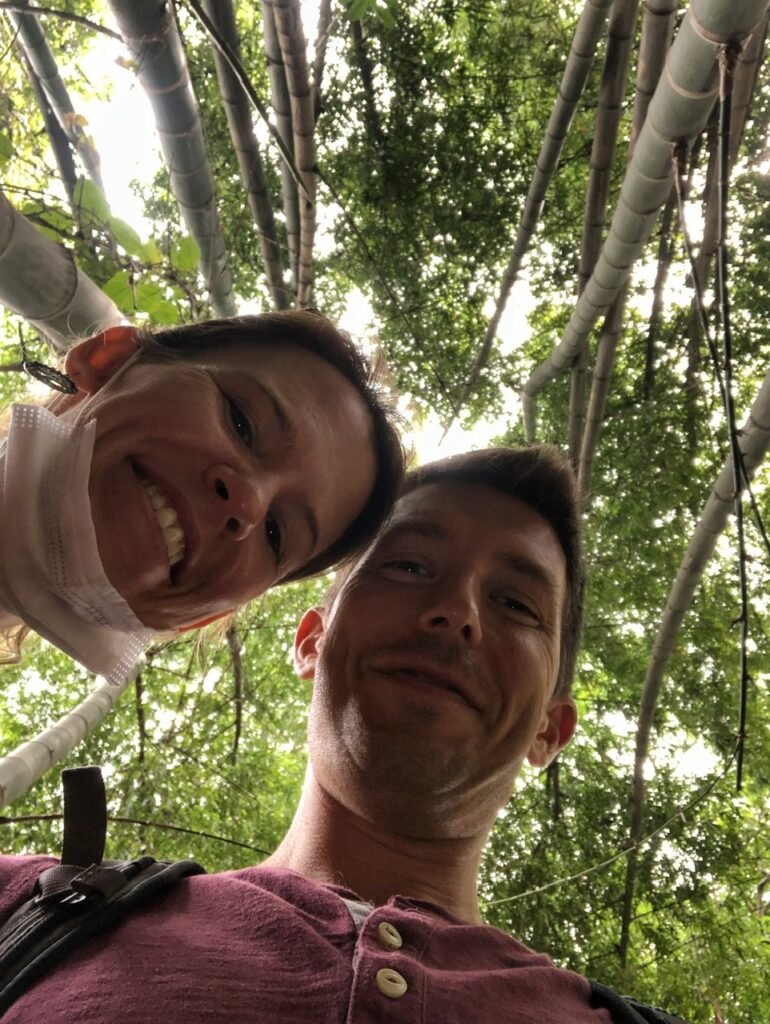
“Lost” in a patch of bamboo.
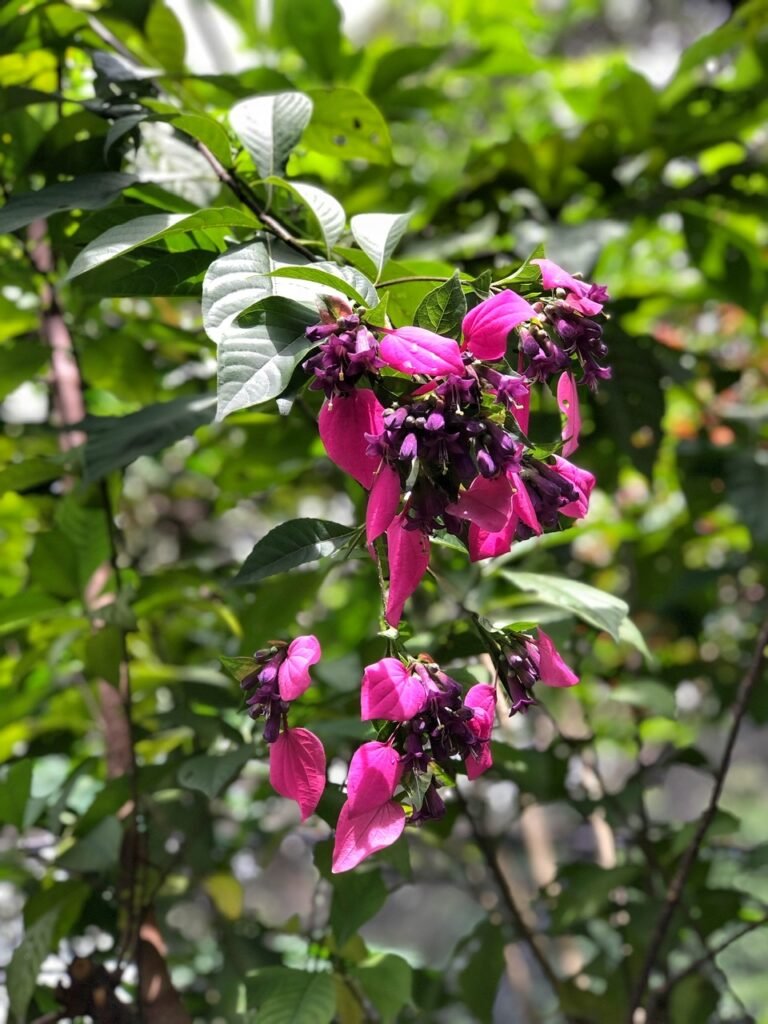
An unidentifiable, yet very beautiful pink and purple cluster.
In the butterfly house, which cost $1, we got to see tons of varieties of butterflies, including this one as well as the rare Blue Morpho, but it’s not too easy to take a photo of those flitting little guys, so you’re stuck with these for now.
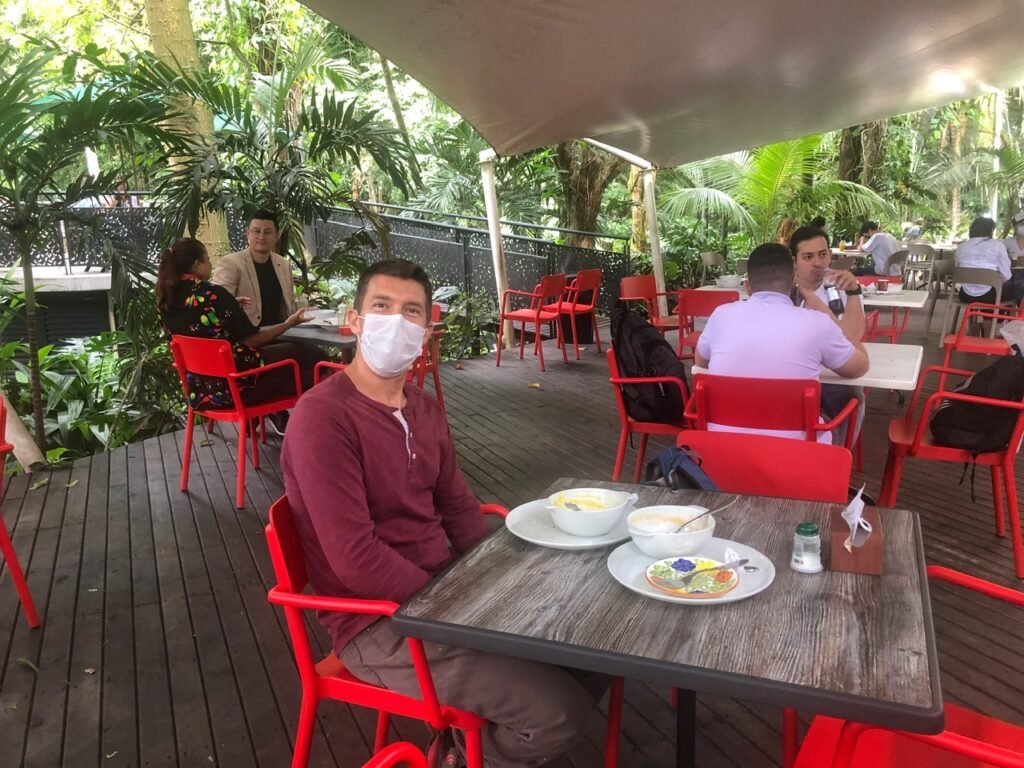
Grabbing lunch at a restaurant within the garden
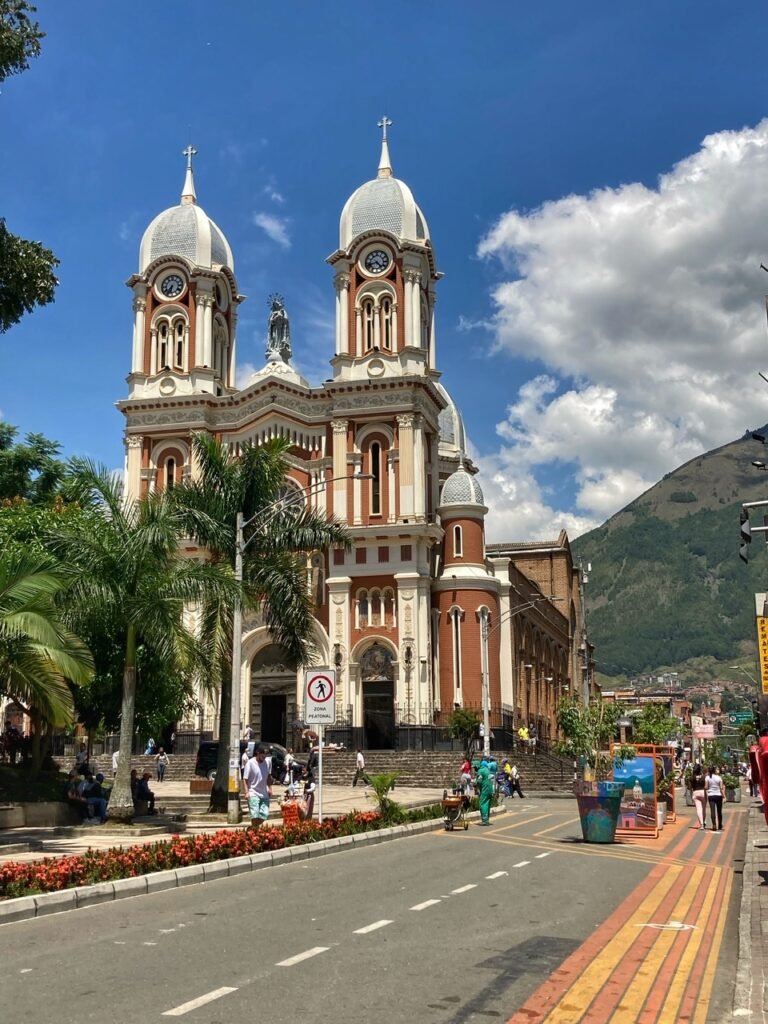
Bello (North Medellin)
We’ve learned that there are quite a few cities surrounding Medellin that were once independent, but have since been swallowed as suburbs. Bello, which is north of the Medellin, but also conveniently on the metro line, obviously means “beautiful” in English. However it was named to honor Andres Bello in 1913 even though it was founded in 1676 as “Hato Viejo” which means Old Herd. The people demanded it be changed in the early 1900’s because they didn’t like that their town was an animal reference. The city is also known as the “City of Artists” in Colombia. (Wikipedia). It seemed like an interesting place to check out on our quest to discover different parts of Medellin, although I’m not sure we’d recommend going out of your way.
The main plaza of Bello holds Santander Park with a beautiful church. This is undoubtedly the most lovely part of the city. It has pedestrian streets that fan out like a star from the middle and which takes about an hour looping in and out of them.

The token welcoming sign. We just saw these are now all over Bulgaria. Is Instagram what made these so popular?! At first they were cool but we’re over them. (As Mandy poses for a picture with it?)
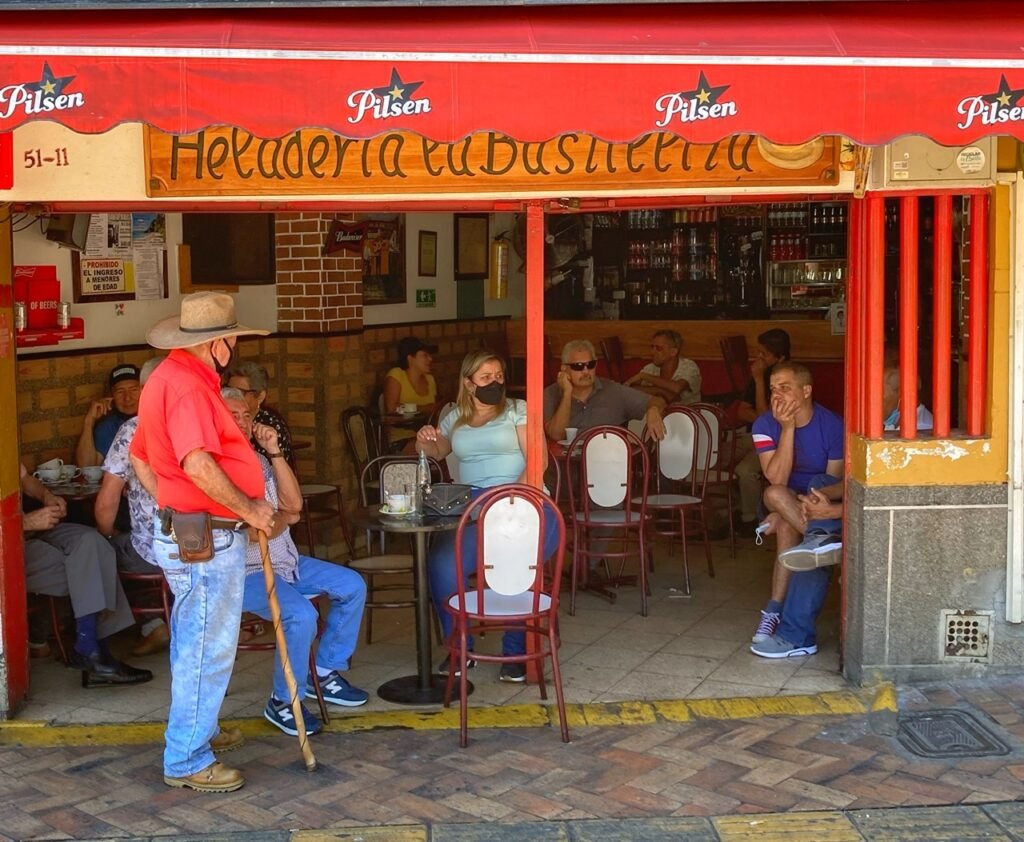
A lazy Sunday morning at the cafe.
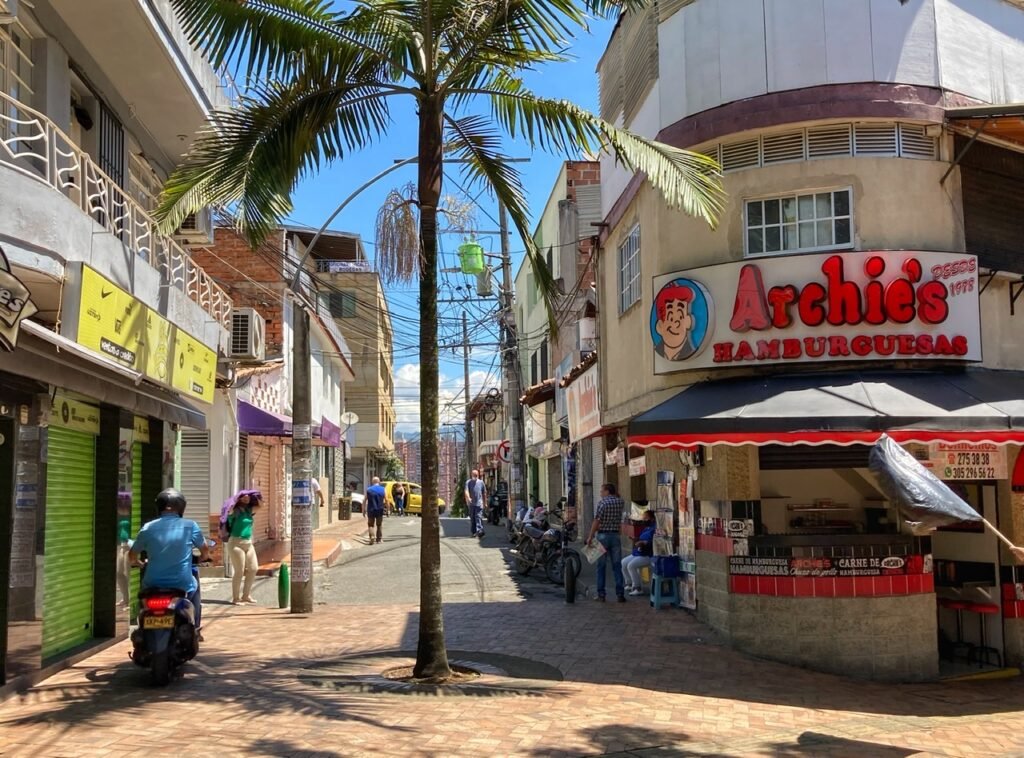
We thought it was cute they had an Archie’s hamburger stand. Other than that, the food selection in Bello, at least on a Sunday, consisted of greasy fried Colombian spheres and triangles stuffed with meat, cheese and vegetables and several rice places offering buffet style offerings that looked remotely looked like Chinese but taste pretty abysmal. We know because this was our lunch. Not what we’ve experienced elsewhere in Medellin so obviously a bit disappointing.
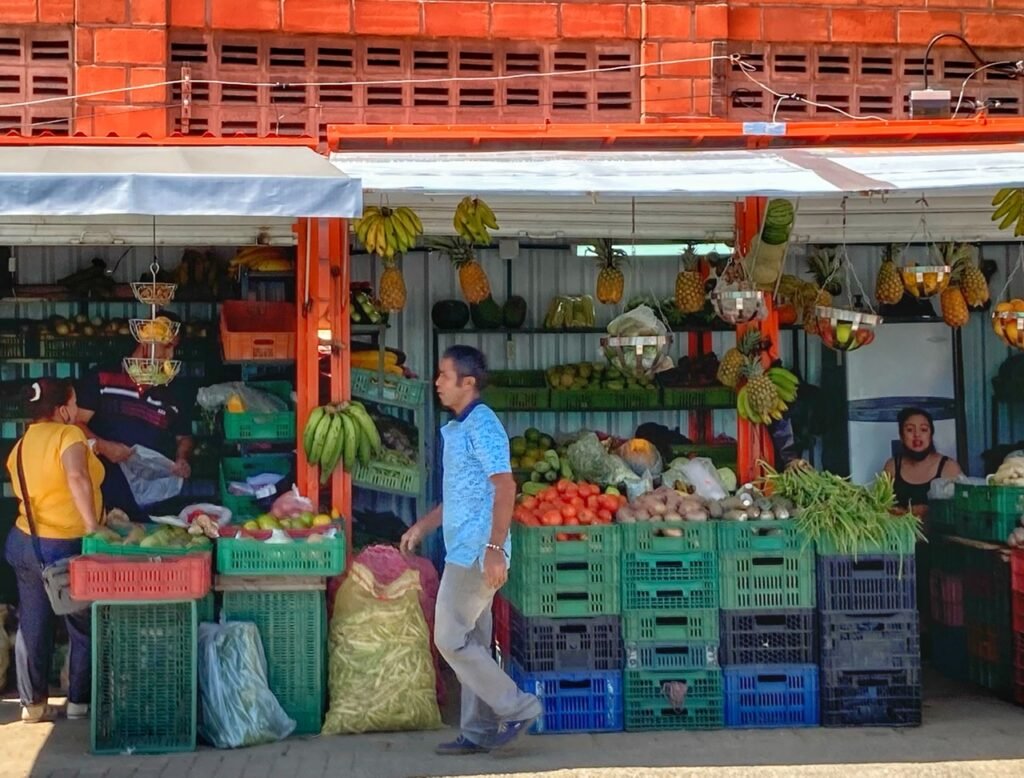
The produce stands, as usual, looked terrific however.
Street scenes in Bello.
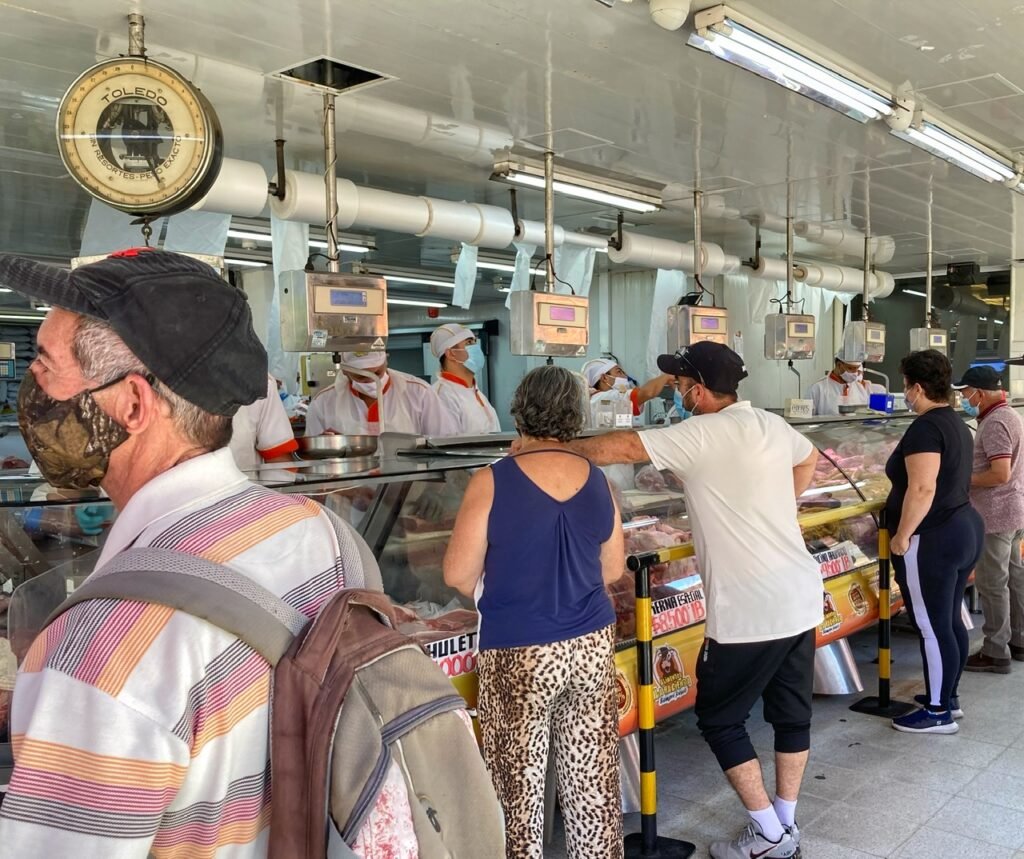
There’s always a long and complicated looking queue at the butcher places. They LOVE their red meat in Colombia. Mandy isn’t overly thrilled with that part. ?

The main park

We dropped into the main church during service. (Note: when is it not service around here? Ha!) As with other churches we’ve seen here, it was quite striking on the inside.
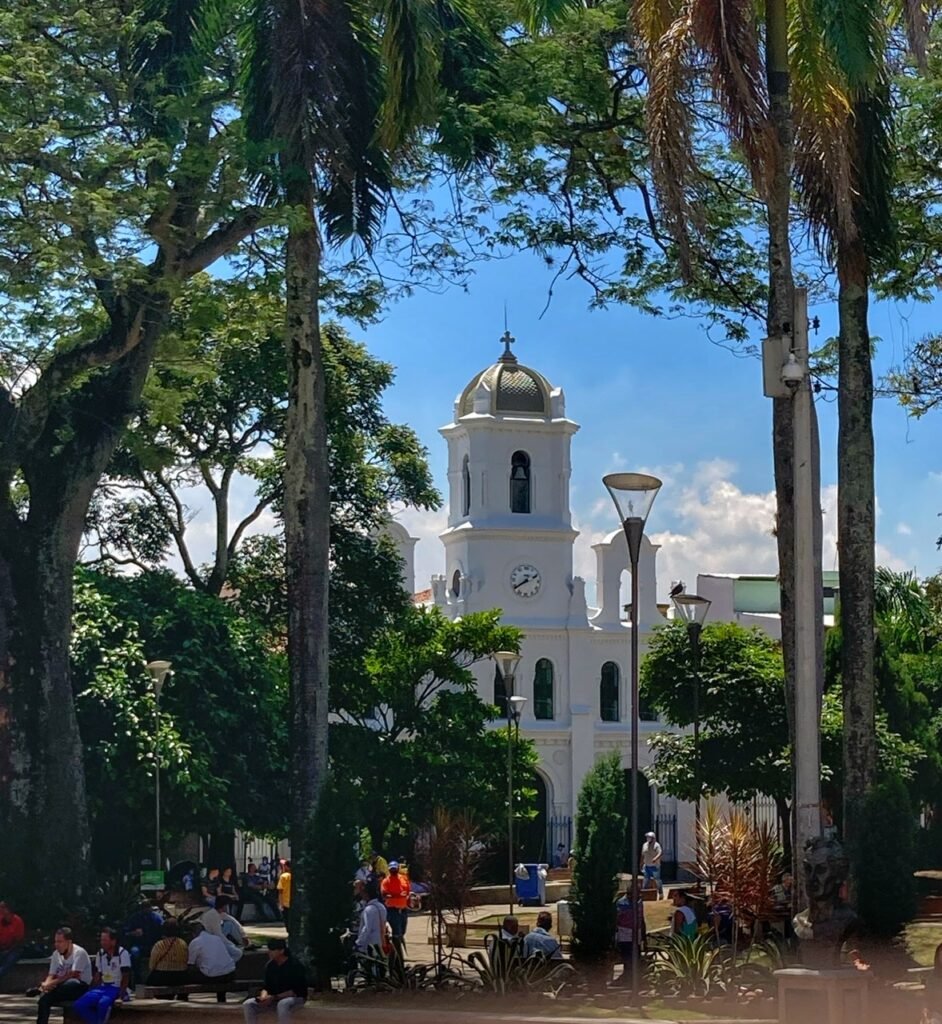
Another, seemingly much older church, on the main square.
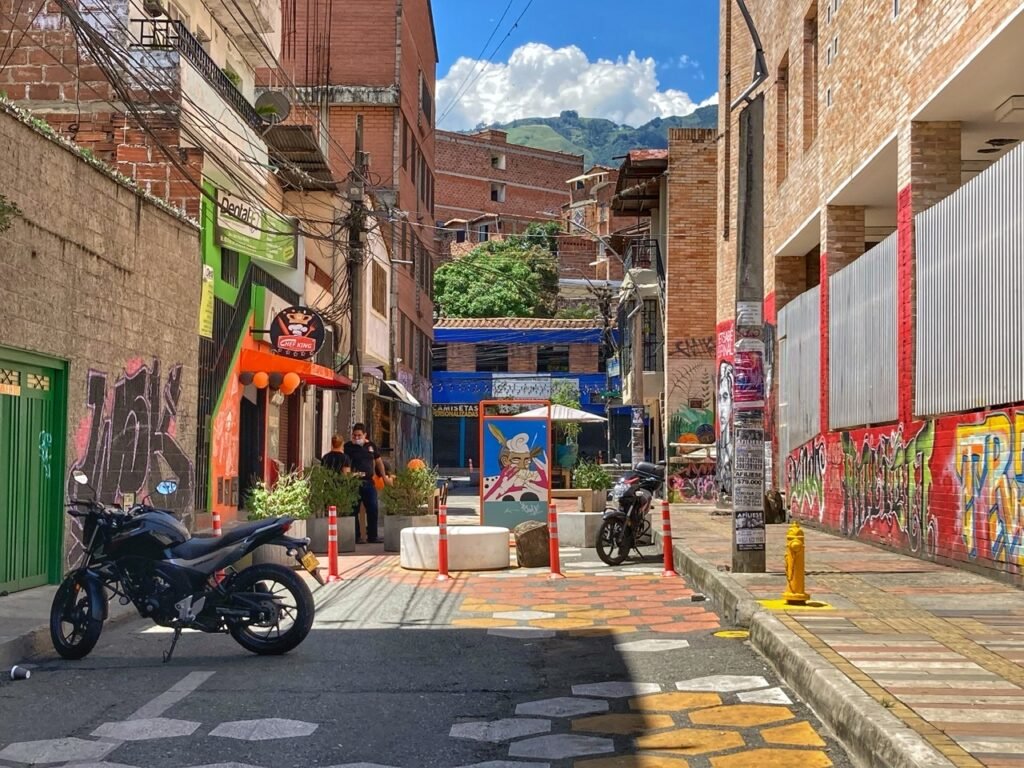
One of the colorful side streets.
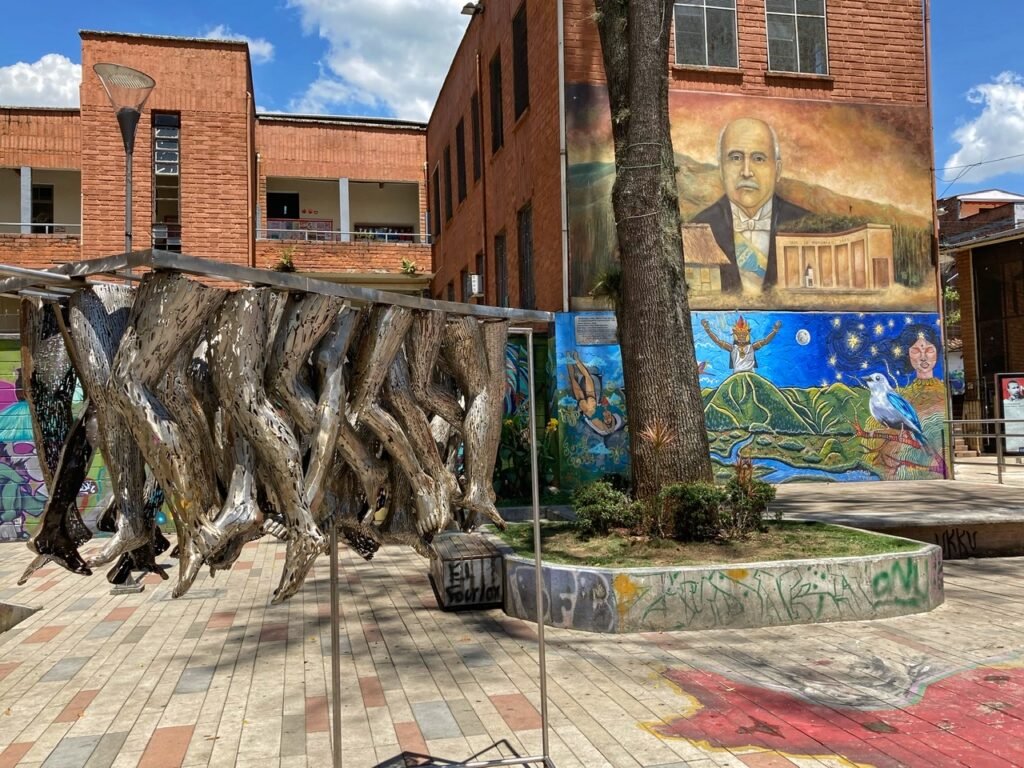
However, the art at the public library has a leg up!
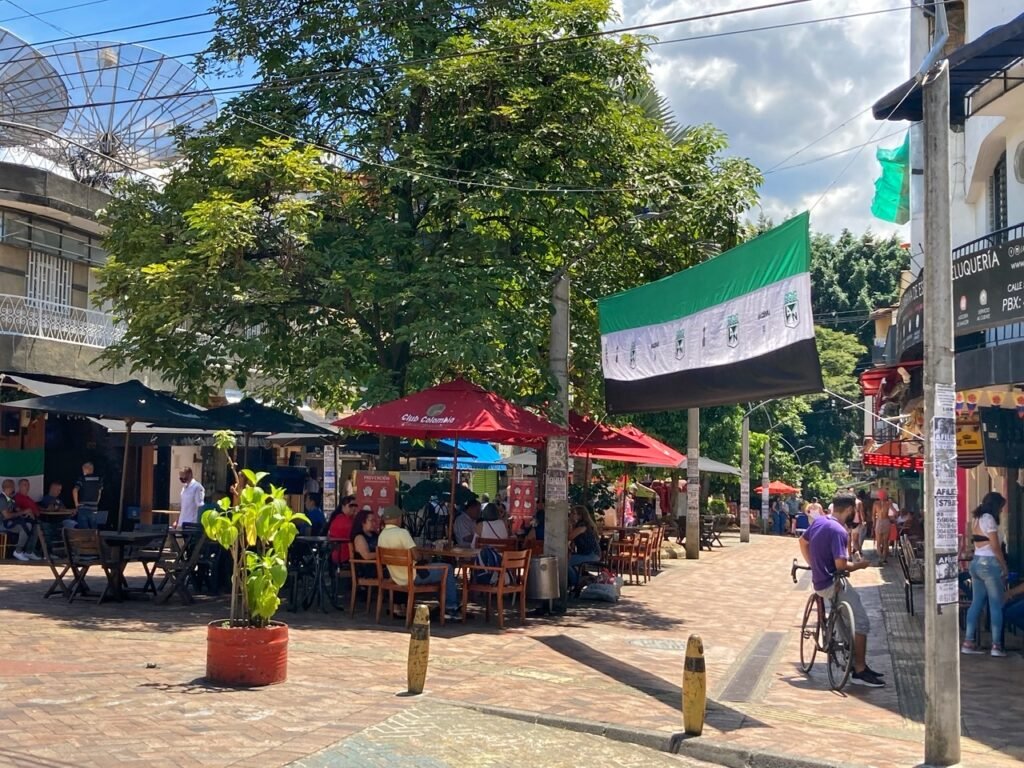
One of the pedestrian streets. Everything seemed pretty bike friendly also.
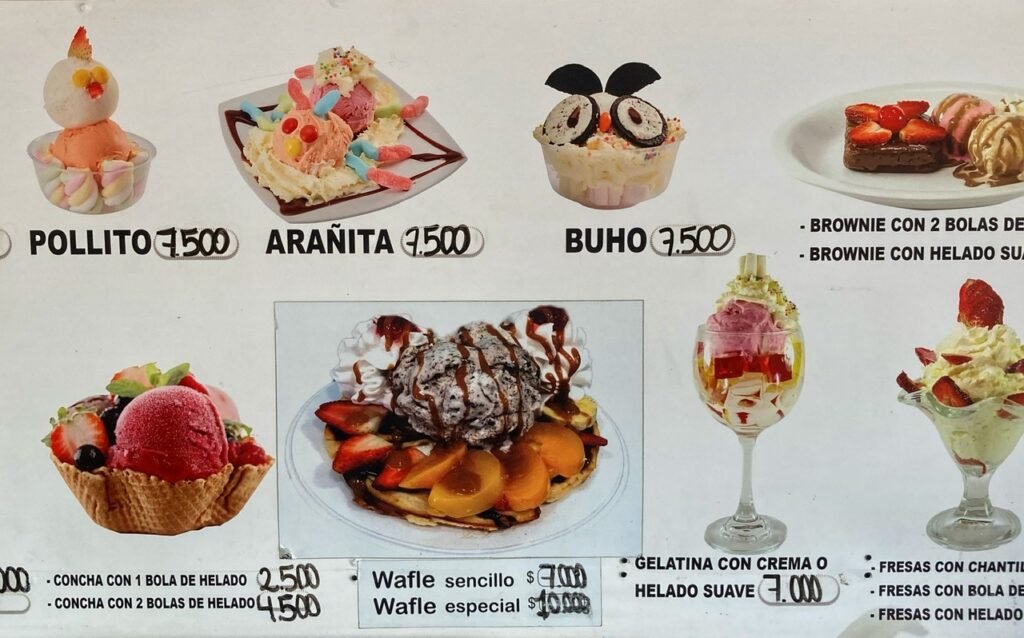
And as in all parts of Medellin, there seems to be no shortage owls, spiders, and chickens dressed up as ice cream offerings. All priced between $.67 and $2.67 USD. Yum.
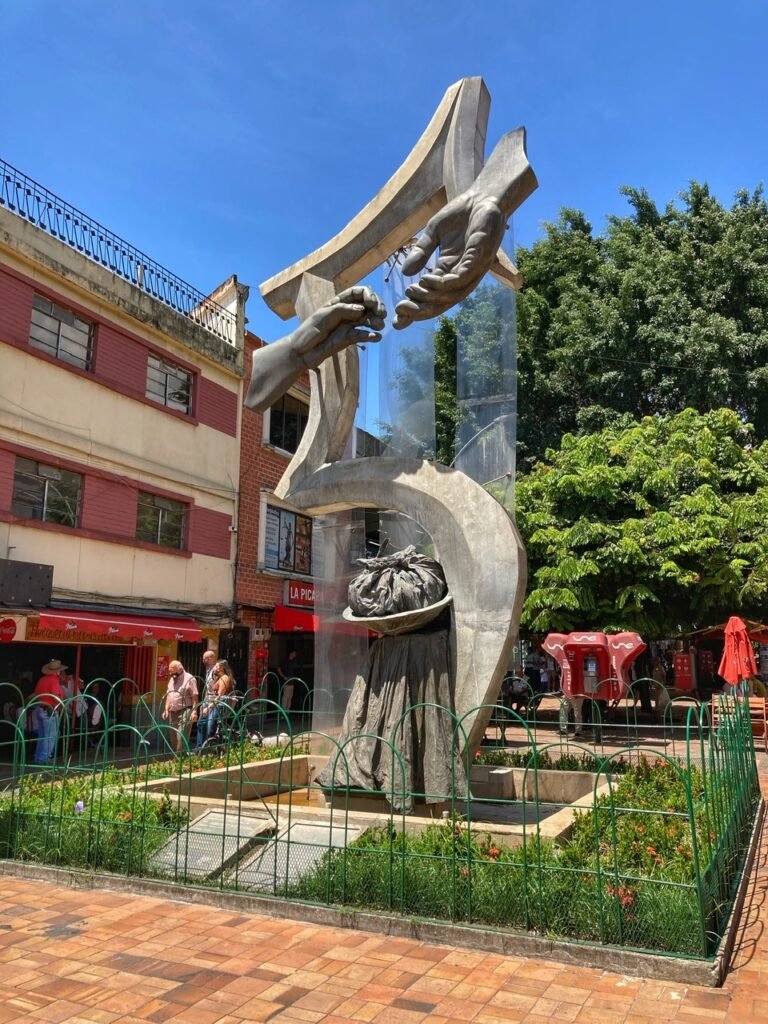
People helping people. Seems to be what this piece of art may represent. That said, we just want to note that, just as we remembered…the Colombians, even in this big city, are so very friendly, patient and helpful, especially when it comes to Spanish. We love this culture and these people so much.
Speaking of the people, Mandy was also absolutely elated for the opportunity to meet her online Spanish teacher (since April) in real life, who happens to be from Medellin. She originally chose Daniela because the Colombian accent is one of the easier accents to learn from. As they do twice every week, their entire meeting was conducted in Spanish! Progress! 🙂
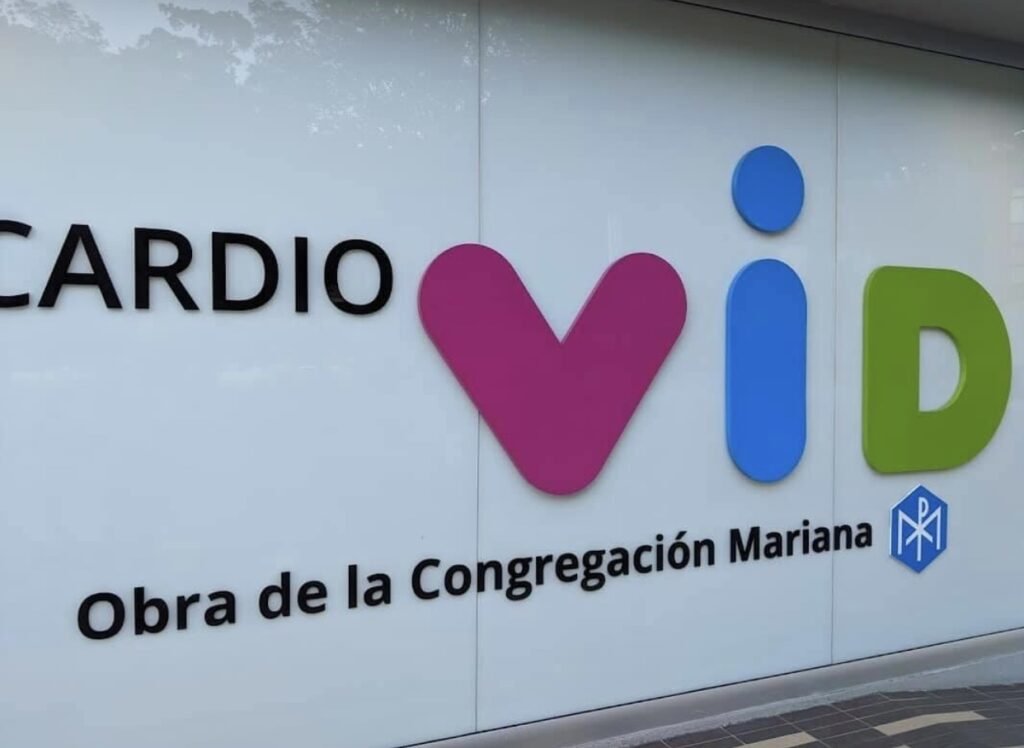
Taking Care of Business: Our Medical Visits
Also, while in Medellin, we both decided to get second (and third) opinions on ongoing medical issues we’ve been dealing with. Here’s what the process looked like for Mandy:
- I found an English speaking electrophysiologist through expat groups on Facebook.
- I emailed the cardio clinic a couple weeks ago and asked for a holter monitor and EKG, and echo knowing this is what I needed to evaluate my arrhythmia.
- I was given an appointment the day of my choice to do the tests and a follow-up consultation two days later. I was also given a list of prices and although they look scary this is because the Colombian peso is $4000=$1:
- Holter monitor: 295.000 pesos ($79 USD), ECG 55.700 pesos ($14), Echo Cardiogram 480.90 ($128), & Consultation 143.500 pesos ($38). Total cost: $259. Tests that would costs thousands in the US without insurance.
- Following my tests, I met with a very friendly English-speaking doctor who immediately gave me his email address for any questions, and then spent an hour with me evaluating results from both doctors I have seen in the States as well as Mexico City, as well as the new results. My heart is still structurally good and normal. I still have an arrhythmia, but it is 18% instead of 21% abnormal heartbeats that it was a year ago…without medicine.
- So, as long I continue to not have symptoms, he does not think it’s necessary to treat with medicine, which is contrary to what the doctor in the US told me who seemed to be think I should take it indefinitely. However, I do need to monitor it with biannual tests to confirm all is still well.
- The important thing is, I feel good, I can exercise to my heart’s delight and I have peace of mind knowing it didn’t break the bank to find out.

